The ALMONDBURIAN
THE MAGAZINE OF THE OLD ALMONDBURIANS’ SOCIETY



Editor: Roger Dowling July 2024

TO say that your Committee have been busy since the last magazine would be a massive understatement. You will remember that at the AGM and in the last magazine the issue of a possible change of name for the Society was again discussed at great length. It resulted in a flood of emails, some of which you can read in an extended Postbag on page 50. I am de -

lighted to tell you that the proposition to change the working name of the Society to ‘The ‘Almondburians’ Society’ was finally adopted at our May committee meeting. We plan to implement this from the start of the School autumn term, which will give us time over the summer to update the website and other documentation.
May I thank all those who have joined
us via Zoom for recent meetings and also the large number of members who responded to my request to send in your views. I feel we can now move on to the next stage in our important task of revitalising the Society. and over the summer we’ll be developing a roadmap for the future. Read more about this on page 12.
So what have we to look forward to as summer approaches? First of all may I remind you of the Summer Reunion Concert in Ilkley on Saturday, 6th July. This is a wonderful opportunity to spend a day in Ilkley, have a bite to eat and possibly a drink, before being entertained by the fabulous Leeds Symphony Orchestra. At £10 a ticket it is an offer you can’t refuse! Read more on page 34.
Later in July we are hoping to be involved in the school Presentation/Awards Evening. These events are nowadays held in School rather than the Town Hall and provide us with a chance to meet the successful students together with the staff. I have been speaking to our Principal, Ian Rimmer, about how the Society might take a more prominent role in proceedings, such as providing refreshments and actually meeting the students receiving awards sponsored by our members. I will keep you informed of this initiative.
On returning to School after the summer break we can again look forward to helping Abbi Terry and her team of Senior Students open up the School for the Heritage Weekend event (see page 9). The date for this in case you would like to join us is Saturday 14th
September. The School will be open for visitors from 10.00 am to 2.00 pm. It is always a lovely occasion and well worth putting in your diary if you haven’t had a look round School for a few years.
In November we once again have the main highlights of the Society year: the annual Founders’ Day Service and Dinner (page 10) The Founders’ Day Service will once again be held in All Hallows’ Church in Almondbury on Friday, 22nd November. We hope it goes better than last year when major works in the church together with a power cut in School resulted in a very curtailed service. Rev Graeme Carby, our Society Chaplain, is once again in charge of the programme of events and we are hoping to have some music from School this time. Again, it is a very pleasant occasion and one to which you are all very welcome. It always ends with a cup of tea and biscuits provided by Hilary Pollard and other churchwardens and we thank them for their hospitality in advance of the event. The service begins in the church at 1.45 pm.
Next day, Saturday 23rd November the Annual Dinner is again being held in School. It is always an enjoyable event and we encourage any of you with a significant date to think about contacting former School friends to join us. Our Secretary Andrew Haigh, will I am sure, be able to help those seeking out contact details of other students from their year.
Finally, may I wish you all a very happy summer and remind you to keep in contact if you have something you’d like to tell us about. n
SINCE the previous issue of The Almondburian was published, there has been very little membership activity. However, we were sad to learn of the death on 10th March of Godfrey Bedford, FPHARMS (1949-57), of Honley (obituary: page 58).
Membership currently stands at 459, with the ratio of former grammar school pupils and staff to comprehensive era pupils and staff being roughly 2:1.
Subscriptions for 2024-25 remain unchanged at £10.00 per annum (£20.00 per annum for overseas members who receive a hard copy of The Almondburian by mail, rather than electronically) and fall due on 1st September. The vast majority of our members do pay their subscription by standing or-

der; if you are one of the few who do not, please remember to make your subscription payment in September.
There is just a handful of members who haven’t yet paid their subscription for 202324, which fell due on 1st September last year. If you receive a letter and subscription form with this issue of The Almondburian, please bring your subscription up to date without further delay, in order to continue receiving the magazine. It makes life much easier if you pay by standing order, so if you can complete the standing order mandate on the subscription form and return it in the envelope provided, that would be even better! Alternatively, you may renew online, using PayPal or a debit or credit card, by visiting www.oas.org.uk/membership.php. n
OAS SUMMER OUTING
6th July at St Margaret’s Church, Ilkley
GOTHARD CUP 2024
21st July at Woodsome Hall
FOUNDERS’ DAY SERVICE
Friday, 22nd November 2024 at Almondbury Parish Church
ANNUAL DINNER
Saturday, 23rd November 2024 at School
Executive Committee meetings are held at 6.00 pm in the ODH at School, with a Zoom link for those unable to attend in person. Any member of the Society who would like to attend one of these meetings will be made most welcome on the following dates:
Monday, 1st July
Monday, 4th November
Monday, 2nd September Monday, 2nd December Monday, 7th October
If you would like to join us for any of the above meetings and are unable to attend in person, then please e-mail the secretary at andrew.haigh@oas.org.uk to request login details, an agenda and any other documents.
Despite seemingly endless ‘new initiatives’, schools continue to face serious challenges with regard to funding and teacher recruitment.
Ishall begin at the end. Having just re-read my contribution to The Almondburian this time, it feels rather like déjà vu . The Principal ‘banging on’ yet again about the ‘serious and significant’ challenges schools are facing these days. Yet, bang on I must as the situation is genuinely serious and significant.
It is often said that education goes in cycles, and those readers who have experience of working in the sector will certainly recognise the feeling that if you wait long enough you will see the same ‘initiatives’ coming around again. Yes, perhaps they are repackaged, rebranded or even re-languaged, but they are essentially saying the same thing, the only difference each time being the ‘creator’ of said new ‘initiative’ confidently sharing their all-conquering wisdom as if it were the proverbial magic bullet. Spoiler, magic bullets don’t exist!
Now, before I continue, I sense the grammar scholars amongst the readership berating the falling standards at King James’s School these days, noting that ‘re-languaged’ isn’t actually a real word, and yes, you are correct, it isn’t. However, that didn’t seem to get in Shakespeare’s way, for not only was he a timeless (the greatest of all time?) playwright,

he was also a prolific inventor of words. For example, and being of mathematical rather than literary persuasion, I confess I did look these up:
Critic Love’s Labour Lost 1598
Dwindle Henry IV, Part 1 1598.
Green-Eyed (to describe jealousy)
The Merchant of Venice 1600 Swagger A Midsummer Night’s Dream 1600
Elbow (as a verb) King Lear 1608
Lonely Coriolanus 1616
And perhaps of more relevance to my offering, Shakespeare created, or gave new meaning to, more than 300 words that begin with the prefix ‘un’:
Unaware Venus & Adonis 1593
Uncomfortable Romeo & Juliet 1599
Unreal Macbeth 1623
Now, you may indeed have been unaware of this fact yourself and are now

perhaps left feeling uncomfortable about this unreal revelation, or perhaps you are green-eyed at my swagger as your confidence in your own literary knowledge dwindles. Others may be critical of my offering and prefer to elbow my thoughts aside.
But I digress. Back to the cycle of education, or should I say termly staples: recruitment crisis, funding cuts and Ofsted.
It was recently announced that the government had failed to meet its own 2023/24 postgraduate initial teacher training (ITT) recruitment target by a mere 50%, including just 17% of the required number of physics teachers. One might argue that the subsequent decision to reduce its 2024/25 target looked suspiciously like an attempt to make the recruitment figures look better.
The simple reality, of course, is that we have a critical shortage of teachers nationally. And this shortage often means very few trainees are in the market and applying for posts, which in turn means schools are struggling to get that burst of enthusiasm and innovation. What it also means is that supply and other teacher-associated costs go up, but funding doesn’t. A clever wheeze, a phrase not invented by Shakespeare, is for the government to
announce that staff pay rises are funded. To most that may appear perfectly reasonable, but what most will not notice is the subtle, but critically important, absence of the adverb ‘fully’!
And thus, schools experience yet another tightening on budgets that are already struggling for breath. It was reported recently that thousands of schools now face severe financial hardship because of a technical funding change which meant that they got a 0.5% per-pupil increase. I’m pretty sure, last I checked, that inflation was still considerably above that figure. Minimum per-pupil funding levels (MPPFLs), which guarantee trusts and councils a certain amount of cash for each child they teach, usually rise at the same rate as school funding increases each year. Since 2018, the rates have risen by between 3 and 7 per cent.
For King James’s School, that equates to a shortfall somewhere north of £80,000.
But this year, the government only increased MPPFLs by 0.5%, despite school funding rising overall by 1.9%. Minimum levels are due to go back to rising in line with overall funding again next year, so will increase by 1.4%. But, as each year’s funding becomes the baseline for the next year’s rise, the 0.5% increase is now ‘baked in’. Another good wheeze!
For King James’s School, that equates to a shortfall somewhere north of £80,000. All too often, or should I say
far too often, I hear politicians using the phrase ‘making efficiency savings’ where it is in all honesty cuts, pure and simple. Of course, like every other school, we will continue to do everything possible to mitigate against the impact of these funding shortfalls, but there will come a point in the not-too-distant future when sustainability, safeguarding and security become compromised. Last year, the Confederation of Schools Trust’s (CST) poll found just 46% of academies reported feeling very or quite confident about the financial sustainability of their trust. This was down from 77% in the previous year. Sutton Trust polling released last year also showed that 66% of heads said they had to cut the number of teaching assistants, up from 42%. In response, the government said money for schools funded at the minimum would actually rise by more than 0.5% because of an additional grant to cover some of this year’s teacher pay rises. However, this was cash that was effectively already spent on covering increased teacher costs

to her guns when discussing the inspection of Ruth Perry’s school, after the coroner found “the headteacher’s death was likely contributed to by the Ofsted inspection”, suggesting Ofsted did not get it wrong. I think many will believe she is still missing the point when making comparisons, as she did, to it being “like a doctor, sometimes the doctor has to give you a difficult diagnosis. And you cannot not be upset by it, however kindly and sympathetically they give it to you” and asking, “Are we in a world where it is impossible to give a tough message or if somebody who gives a tough message is assumed to be bad by reason of giving the message?” It isn’t about the message, it’s about how that message is determined and delivered, and the unnecessary high-stakes implications of that oneword message.
And so, to the ‘O’ word: Ofsted. In a recent podcast the former Chief Inspector, Amanda Spielman, was sticking
In the same interview, she also made some comments about school closures during the pandemic and their impact on children’s wellbeing. “It’s very clear”, she said, how much children have suffered from the disruption on so many fronts”. She went on to state, “delayed socialisation is the cause of the behaviour problems” which many schools are now experiencing.
With her on that I can agree! n
King James’s School will again be open to visitors as part of the ‘Heritage Open Days’ event, on Saturday 14th September. WALTER RALEIGH reports.
THE theme of Heritage Open Days this year is Routes: Networks and Connections - particularly appropriate at the present time when the Society is striving tostrengthen even further its working links with the School community.
Once again members of the Society will join with Abbi Terry and her team of senior students to lead visitors on conducted tours around the School between 10.00 am and 2.00 pm on Saturday, 14th September. Everyone is welcome and for those with disabilities parking is

This year we are hoping to have more of the School open so visitors can enjoy a look round not only the Georgian and Victorian parts of School but the more recent extensions. The ‘Dorms’ will once again be open but those finding it difficult climbing stairs can. of course, miss out this part of the tour.We are again planning to have our historic Charter (below) on display.

If you have not had a look round the old school for a few years please take this opportunity. You will be surprised both with the additions as well as the remodelling that has taken place. I’m sure a visit would bring back many happy and perhaps not so happy memories of the School!
As every year, I look forward to meeting members who have not been back inside the building for many years and the stories they tell. If you need further information please do not hesitate to give me a call on 07504974568 or email walter.raleigh@oas.org.uk. n

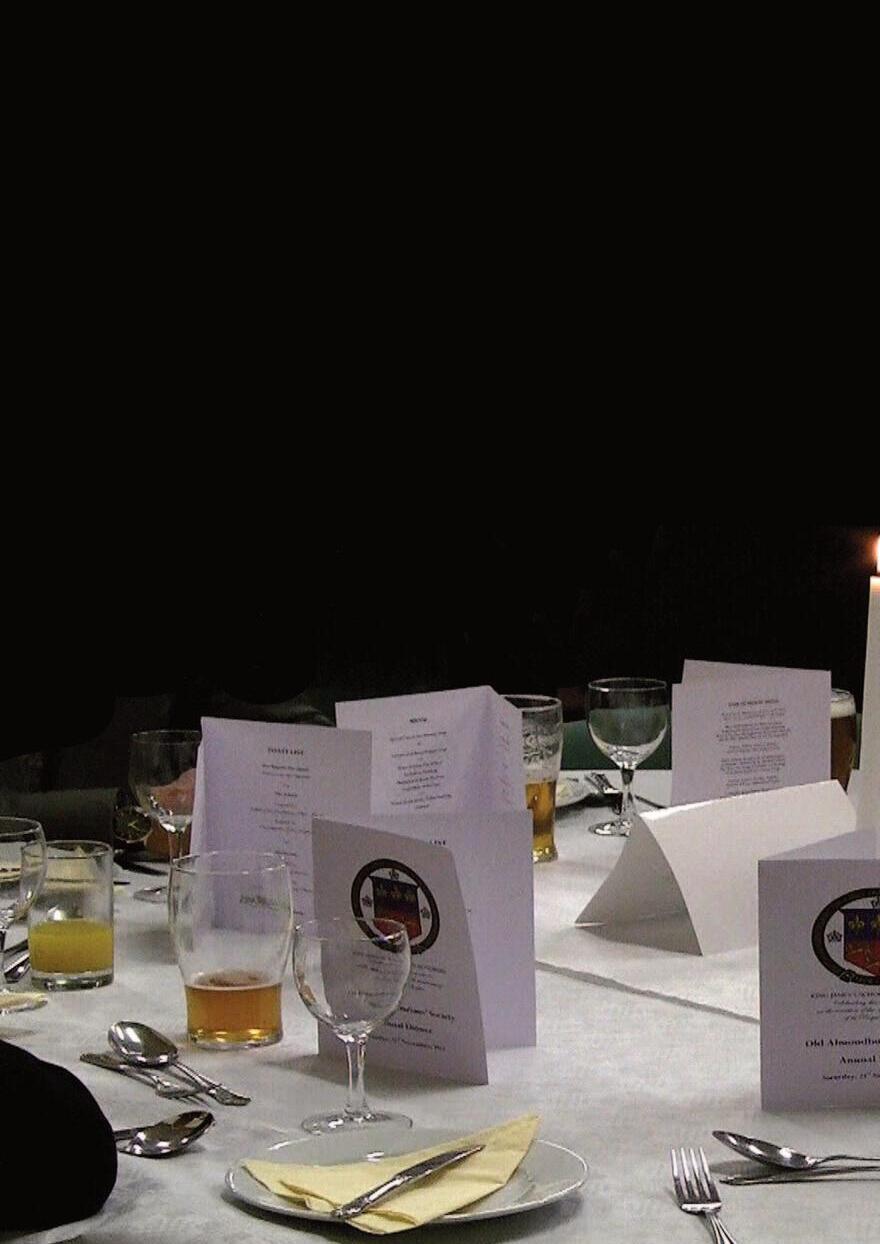
Dinner and Founders’ Day 2024
WE’RE looking forward to another Old Almondburians’ Society Dinner on Saturday, 23rd November at 6.30 pm for 7.30 pm.
Hugh Lawso n is organising a 70th anniversary re-union of his class of 1954 and two members Get your Dinner tickets NOW!
The ticket price this year will remain at £35.00 and an application form for tickets is included with this issue of the magazine. Alternatively, you can purchase tickets online at www.oas.org.uk/buydinner.php. Please be aware that when the Annual Dinner is held at the School places are limited, so early applications are recommended.
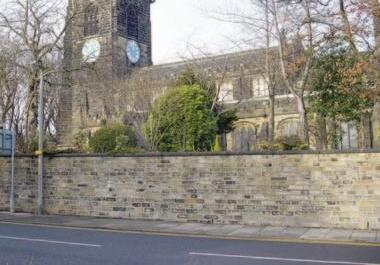
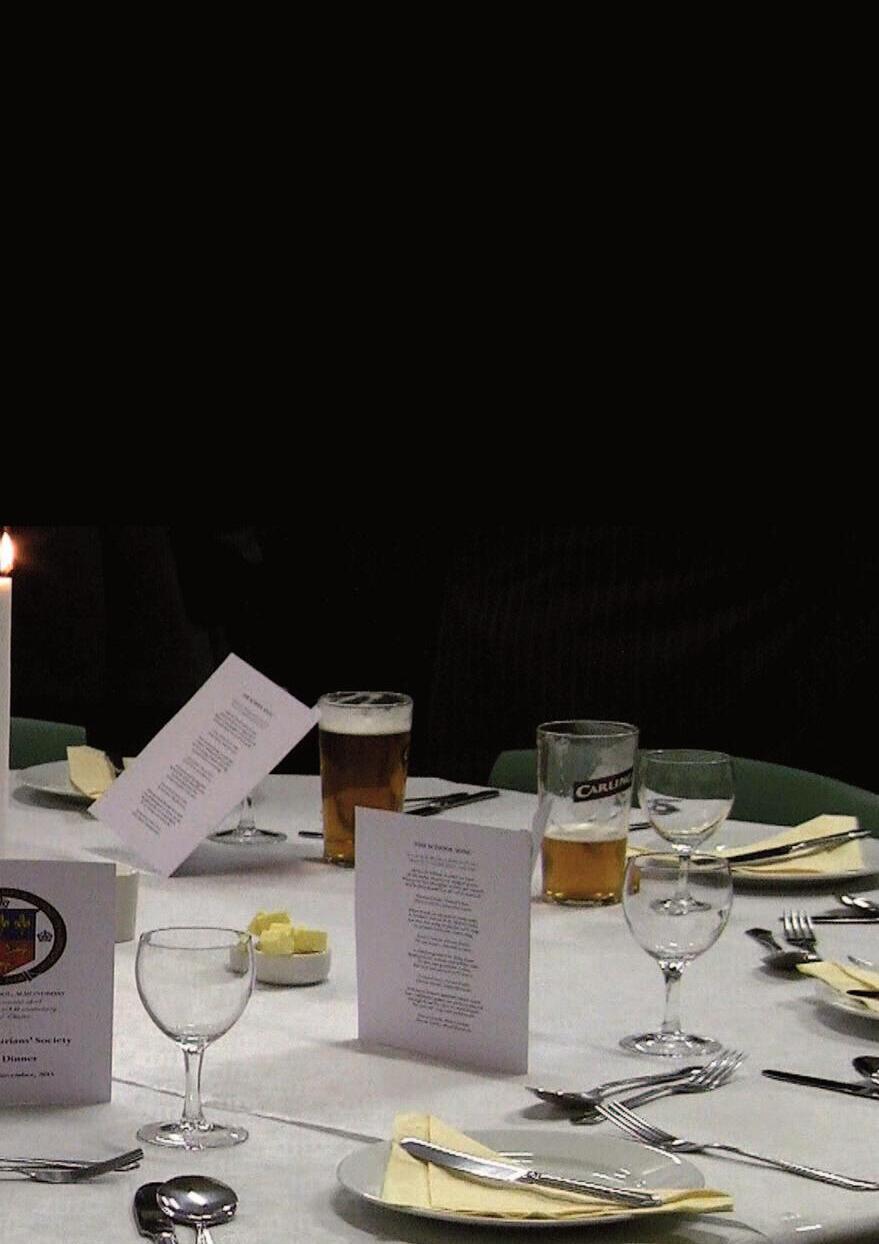
from that year have already bought dinner tickets, despite the application forms not yet having been printed as we go to press!
It is always good to see members making a special effort to stage a reunion of their year at the dinner and such occasions are always enjoyable, so others with a special anniversary this year, members of the classes of 1964, 1974, 1984, 1994, 1999, 2004 or 2014 for example or, indeed, anyone else who takes a notion to do so, should consider starting to organise their class re-union earlier rather than later.
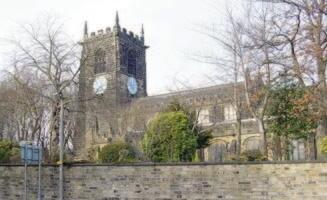
This year’s Service will be held on Friday, 22nd November at All Hallows’ Church, Almondbury at 1.45 pm. It will be led by OAS Chaplain Rev Graeme Carby, and we are hoping that musical entertainment will be provided by pupils from the School. n
l See www.oas.org.uk for further details as they become available.
FIRST of all may I thank all those members who responded to my invitation to respond to my article about the future of our Society in the last issue.Your emails all made interesting reading (see a selection in the Postbag on page 50) and many had specific ideas on how we might take the Society forward. The emails displayed great affection for the School and the time you spent there. It is this goodwill to wards the School we must now build on to make progress.
The first step has now been taken.Your Committee agreed at its May meeting that we should now, for work ing purposes, call ourselves the Almondburians’ Society. One does not have to be ‘old’ to join our Society: we believe the new name emphasises more clearly that our common link is that we are all Almondburians.

We now we need to develop a roadmap to guide us towards the more important issue of how to attract more younger members to the Almondburians’ Society, and particularly those from the King James’s School era. Amongst the many responses one stuck out: that as a new pupil or member of staff enters the School they are auto-
matically ‘Almondburians’. The Society should therefore forge much closer links with KJS staff make them more aware of the long history of the School and how it has developed over the centuries. This will enable them to better understand the affection we Almondburians have for the School and why it means so much to us. Of course, this is not going to be easy as demands on teaching staff continue to increase. For those not in education it is easy to underestimate the pressure staff are constantly under to improve the grades of students and improve performance in national league tables. So we have crossed the Rubicon! There is no turning back. We propose to use the new name from the start of the School autumn term as it will give us the summer to make some necessary implementation changes - for example to our website. Over the summer, I plan to set up an implementation team to develop a roadmap to explore ideas for growing the Society and making it more inclusive, using Zoom so anyone can take part wherever they live. If you would like to join the team, just drop me a line at walterraleigh@hotmail.co.uk. I look forward to hearing from you. n



New concept



Spotters: James Clayton, Keith Crawshaw, Roger Dowling
Have you spotted anything in print or on social media that has amused you or given you food for thought? If it’s worth sharing, send it to us: spotters@oas.org.uk.

In this new series The Almondburian profiles key members of the current King James’s School teaching staff
The Almondburian Many readers will be unfamiliar with the idea of a faculty of Humanities – a term unknown back in the Grammar School days! What subjects does it embrace at King James’s School:
Ian Williamson It covers quite a broad range of subjects: History, Geography, Religious Education, PSHE (personal social health education), and until recently, Classics and Sociology.
A That’s quite a range! What are the other Faculties in addition to your own?
IW Mathematics; English; Science; Modern Foreign Languages; Art/Business/ Computing/Design; and Performance (Music, Drama and Sport).
A How large is the Humanities faculty?
IW We have seven full-time staff, four of whom specialise in History and three in Geography.
A Do you do much teaching yourself?
IW Yes, I still do a lot of teaching, albeit to a slightly reduced timetable as head of faculty.
A What part of the world are you from?
IW Norfolk, though I’ve lived in many places since then. I studied at Brighton University and then taught in London and for a couple of years in Mombasa in Kenya.When we returned to the UK we decided to live in Holmfirth.
A How long have you worked at King James’s School?
IW I’ve worked here since 2008.
A What were your first impressions of the School?
IW Funnily enough, I’d driven past the School many times before I had the interview, not even noticing it as it’s so tucked away. The old part of the School is very beautiful and the valley, as one drives down from Farnley Tyas, is really lovely.
A In a comprehensive school, how do you cope in practical terms with teaching pupils of mixed abilities and from all sorts of backgrounds?
IW In some subjects, pupils will be settled into different higher and lower ability groups. But in History, for example, we try to go for mixed ability, stretching the more able by giving them more challenging work but supporting the less able with what we call structured work.
A Do you regret not having a Sixth Form at KJS?
IW It is enjoyable teaching that age group, which I have done in the past; but Huddersfield is lucky in having really good Sixth Form colleges like New College and Greenhead.
A With around 1,100 pupils today, the School is much bigger than it was in the days of many of our readers. Can you honestly say that you know the name of every pupil?
IW No, that’s just not possible. But I definitely know the name of every pupil I
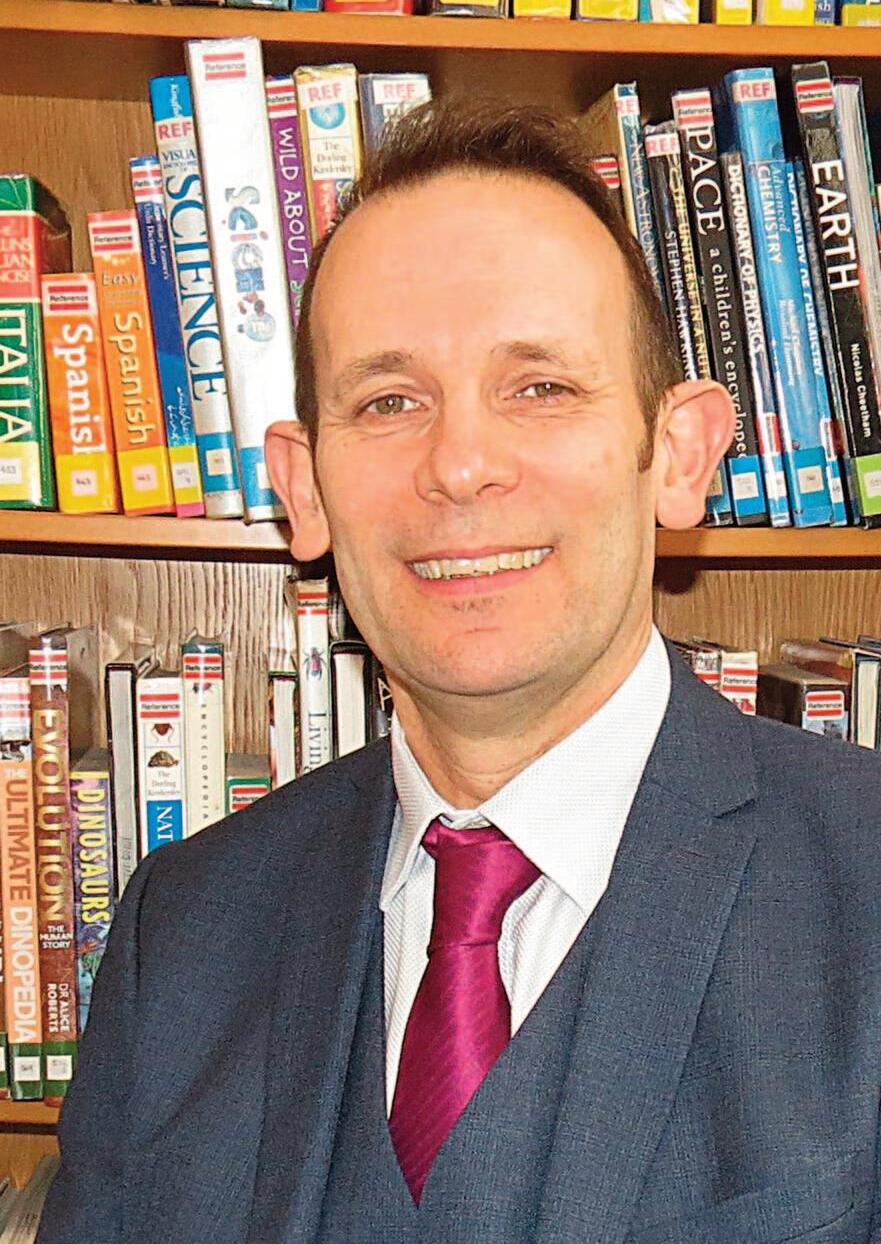
teach! Some of my teachers are teaching 300 children over a two-week period, so it’s quite a massive challenge. But in general teachers are quite good at learning names and assessing the character and ability of each pupil - that’s actually key to becoming a successful teacher.
A How do you address pupils nowadays - and how do they address you?
IW We always use forenames of pupils and they refer to teachers as ‘Sir’ or ‘Mr/Miss’.
A Some years ago, the School hit the headlines because it was said to have introduced very strict rules about pupil conduct. Is KJS a very strict school?
IW What we try to do is to strike a good balance. Ultimately, our aim is simply to produce the best results from every pupil. We work very hard to achieve a purposeful working environment, and as teachers we try to model the kind of behaviour we want the children to have.
A We carried an article in the magazine a few issues ago about the whole business of punishment in schools. What is the approach today?
IW I suppose the ultimate punishment is exclusion: very occasionally a child will be asked to leave the School. Before that stage we have a system of warnings, ultimately leading to the student being sent to a separate ‘turnaround’ room or a so-called ‘reflection unit’. On a day-to-day basis the first tactic has to be to have a good relationship with the students in the first place, to make them want to be in your classroom and make them want to learn.
A We’ve read a lot about Ofsted inspections in recent months and, perhaps surprisingly, the Government has decided to
retain ‘single word’ judgements. What is your view on this?
IW I don’t think any teacher enjoys going through an Ofsted inspection, but I do think you need an objective outside view of the School. But is it realistic to assess a school on the basis of an inspection lasting only two or three days? And then just giving a school a single word judgement doesn’t really tell you very much. But we’re had good inspections since I’ve been here - ours is a good solid school.
A What is the biggest challenge in teaching today?
IW I think it’s the workload. Teaching is a very intense job - you never really stop from the moment you enter the door. So the main challenge, particularly as you get older, is maintaining one’s energy levels. Lessons are best and children learn best when the teacher is enthusiastic and has lots of energy.
A If you had a magic wand, what changes would you like to see in teaching?
IW I think it would be to reduce the size of classes.We usually teach around 30 pupils at a time, and it would be much more manageable if it were reduced to 20. Secondly, our teaching system in the UK means that children have to narrow down their education very early. If you look at other countries around the world, that kind of narrowing doesn’t happen quite so early.
A What are your personal ambitions for the future?
IW With retirement on the distant horizon, I suppose the days of ambition are probably behind me! I have had a year as Associate Assistant Headteacher, but ultimately it’s teaching in the classroom that I really enjoy. n
Exactly 30 years ago, the remaining 10 workers at Bamforth Postcards lost their jobs when the Holmfirth firm closed after 124 years. It was a sad day for James Clayton who nostalgically shares a few cheeky memories from his collection.
IN 1994, my wife and I were in Scarborough for a short holiday. We came across a poster advertising an exhibition at the Ro tunda Museum. It was commemorating the 100th year of the pic torial postcard. This was being celebrated countrywide in differ ent ways. 1894 to 1994 was the period being celebrated and Scarborough chose to hold this exhibition. We went along and found it very interesting. It dealt with a wide spectrum of subject matter but it was the saucy seaside postcard which put a smile on my face. As a result, for the rest of the week we were buying such items with one stipulation - they

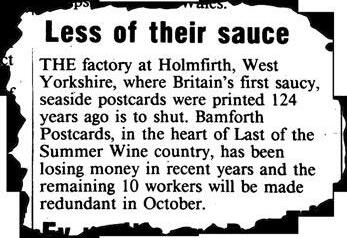
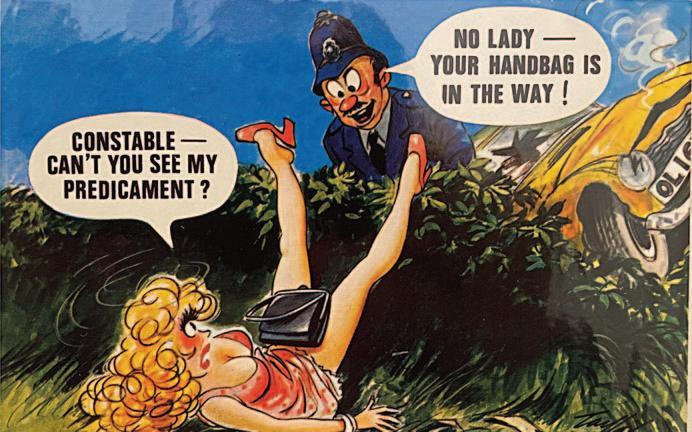

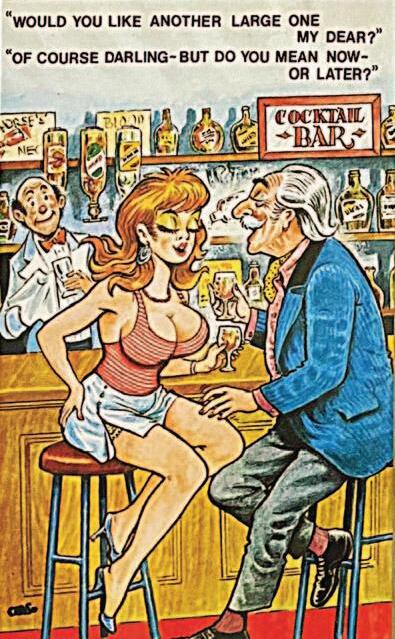
had to be published by Bamforth’s of Holmfirth. To my surprise, by the end of the week we had accumulated around 80 cards.
Fortunately when I got home I found an unused ring-bound photo album which provided a perfect home for the collection. I have always been fond of the bold graphic style, colours and humour of this type of card. I didn’t realise at the time that Bamforth’s, who printed the first seaside postcard 124 years beforehand, would be closing later that year.
Around the same time, I had started subscribing to the first-day cover service from the Post Office. I have now got a full album of delightful covers. Coincidentally, one of the first I received was dealing with seaside postcards and had some fine stamps depicting the theme. The script
Continued on page 20
JAMESBAMFORTH (right) was born in 1842 to a family of painters and decorators. Not wishing to follow in his father’s footsteps, he developed a technique for producing slides for magic lanterns, which he would take around local village halls.
In 1898 he set up a partnership called RAB Films with the Riley brothers of Bradford who had just started making silent films. In the following two years they produced an astonishing 14 films with such unlikely titles as The Tramp and the Baby's Bottle (1899), Lover Kisses Husband (1900) and Biter Bit (A Joke on the Gardener) (1900).
F Bamforth at Holmfirth.

Following James Bamforth’s death in 1911, his son Edwin re-started film production and a second sequence of over 100 films was produced from 1913 to 1915.The popularity of these films, in particular those featuring an unlikely character named ‘Winky’, led to a film industry in West Yorkshire which for a time surpassed that of Hollywood in terms of productivity and originality.
From the early 1900s the firm had used its experience in the production of lantern slides to move into the field of publishing, producing sets of postcards which soon became very popular.
The firm of Bamforth & Co Ltd was registered on 30th June 1910 with a capital of £5,000 in £1 shares ‘to take over the business of photo graphic lantern slide manufactur ers, fine art publish ers and photographers carried on by J Bamforth, H Bamforth, E Bamforth and
Many of the postcards were in comic style, and with the encouragement of Edwin Bamforth they became increasingly bawdy, featuring such figures as honeymoon couples, henpecked husbands, domineering wives and shapely scantily-dressed young ladies.The style was established by Douglas Tempest (1887-1954), a Norfolk-born artist who studied at Leeds School of Art.Two other main artists were Philip W Taylor, from the 1930s to 1950s and Brian Fitzpatrick, who joined the firm after Tempest's death in 1954 and continued until he died in 1974.
The risqué nature of the postcards led to problems from time to time with the authorities. In the 1950s a number of shop owners in Blackpool were prosecuted for selling such cards after a complaint from a member of the public. A Blackpool Postcard Censorship Board was set up in 1951 and maintained its public-spirited vigilance until 1968.

By the 1980s, saucy postcards were no longer fashionable and on closure of Bamforth & Co the business was sold to Scarboroughbased E T W Dennis & Sons.This company folded in 2001 and the rights to 50,000 designs are now held by Huddersfield-born entrepreneur Ian

Bamforth & Co in Station Road, Holmfirth have now been converted into private residences.

Continued from page 18
that came with the cover was written by the late Benny Green, writer and musician.
This is what he wrote in 1994:
The seaside comic postcard is one of the great enduring English traditions, and at the climax of its first hundred years thankfully shows no sign of fading away. The reason for its survival has much to do with jokes, which were corny in Chaucer's day and just as funny. Fat ladies and hen-pecked men, anti-social crabs and pigeons, ice cream and lemonade, drunkenness and lechery, all under a sunny sky in a a land where pubs never close and money runs out. A land where even dogs and little fishes know
how to smile, a place where shapely girls acquire husbands and mysteriously triple in size, and there is hardly a remark a self-respecting citizen can make that isn't instantly turned into something vulgar, coarse and very funny. And, most important of all, it is a blissfully indulgent land where you can take all your clothes off! Times they are a-changing! n

Terry

Iam so thankful that after succeeding in the 11+ exams in 1947 I was not accepted for Huddersfield College, but was offered a place at Almondbury Grammar School. A boys’ Grammar School – the right school for me! But living in Longwood in sight of three woollen mills, at one of which my father worked all his life, I had to get to Almondbury on two trolley buses and then walk through Almondbury and down St Helen’s Gate.There was this Grammar School with some very old buildings – “a Chantry School in St Helen’s Gate, as ancient records state.” I was allocated to form 1A with a classroom upstairs in the Old Dormitory and Walter Haigh as Form Master. I wore a blazer, tie and cap; I was in Fenay so my cap had a blue band at the back.
Many lessons were held in our form room, with different teachers coming to us and,mostly wearing academic gowns. But for Geography we went to the geography room to meet with Fred Hudson, and for the sciences we went to the appropriate laboratory. The other specialist rooms were for Art,Woodwork and PT. I did fairly well in all subjects through the five years to taking GCE ‘O’ Levels. My family expectation was that I would then leave and go into employment, but my form master George Beach thought that I should go into the 6th form.There must have been a parents’ evening and he spoke with my parents who agreed to my going into the 6th form where I studied Geography, History and English Literature. It was quite a challenge,


Prefects 1953/54
as all my local friends and many at AGS were starting work and getting money!
The 6th Form was quite different: we had form rooms in the old buildings and were treated differently by teachers: there were more discussions and sharing of thoughts. I was also in the school football team which meant visiting other schools for matches on a Saturday.We had interesting meetings in the Jacobean Society.There were not very many of us in the 6th Form: for my subjects there were only five or six of us.The Headmaster, Harry Taylor, took us for European History and we met in his study.These were the best kind of lessons one could have: he was sharing information and his love for the subject with us.
I stayed into the third year, Upper 6, after obtaining passes in my three ‘A’ levels with the possibility of going to University. I was taken aback when Harry Taylor asked me to be Head Boy – what an unexpected privilege! This also meant leading the prefects in our re-
sponsibility for helping maintaining good behaviour around the School and reading the Bible passage in morning assembly.
I was not sure about University.and whether the academic life was for me or how it would fit with future employment. My father had been unemployed in the 1930s and wanted me to have secure employment with a pension! The main options were Local Government, a bank or the Civil Service. I chose the latter and had to take an examination for entry at Executive Officer level.The exam was akin to GCE ‘A’ level and I did well and was accepted in February 1955 for a post in the Home Office Immigration Branch.This coincided with Speech Day at the Town Hall, when I made the speech of thanks and the Headmaster announced my leaving school and entry into the Civil Service.
So I left School and Huddersfield to work for the Immigration Branch in Hull. Before starting there I went to the Home Office and then to Dover for training which included
crossing the Channel to check passports of non-British subjects on the way back.This was such a significant change in my life, alone in a place I did not know at all. But I found ‘digs’ in Hull and made friends in a local Church, A few months later I had to have time out from the Civil Service to do my National Service in the RAF! I was one of the last to do National Service and if I had gone to University I would have avoided it. A significant change in life: uniform, sleeping in barrack units with many other young men from all walks of life and having to obey orders without question! I was a ‘Fighter Plotter’ and stayed in the UK − MiddleWallop, Norwich, Preston, Linton on Ouse and Boulmer in Northumberland. There were many good experiences with a whole range of different young men and officers. Looking back after a number of years I was thankful for National Service: sharing life with a whole range of young men from many different backgrounds was such a helpful experience for my career in the Civil Service.
I left the RAF after two years and went back to the Immigration Branch of the Home office in Newcastle onTyne. Not long after I was married to Doreen, a young lady from Huddersfield, and we set up home in a furnished flat in Newcastle. After some months I was not sure that the Immigration Branch was for me and an opportunity came to transfer to Social Security – the National Assistance Board (NAB) – and this was to an office in Hull. At least I knew the city and there we bought our first house - a modern semi for £2,800.The NAB was a big change: dealing with applications for a means tested benefit from people, unemployed, sick or retired. Many had a contributory benefit and national assistance was then a top up benefit.To take applications
we visited people in their own homes which really enabled us to get to know the public. I was in Hull for four years and then went on promotion to Social Security Headquarters in London.There I was involved in policy aspects of the benefits which also changed over the years. I became involved in supporting Ministers and significant changes as the Government changed.The first Secretary of State I worked under was Barbara Castle in Harold Wilson’s Government and later under Patrick Jenkin and Norman Fowler. Barbara Castle was very feisty but engaging with staff. I was involved in various aspects of policy and management in the Department of Social Security until 1982 when I went to Birmingham as Regional Controller for Social Security in the Midlands, living in Solihull. This was a most challenging role with responsibility for local Social Security Offices around the Midlands. The challenge was to ensure that benefits were paid accurately to claimants and that they were treated with respect. Because of my role I and my wife were


invited to a Garden Party at Buckingham Palace: really living it up!
In 1990 management of Social Security was transferred to the newly created Benefits Agency with its own Chief Executive and Board of Management. I was appointed an Operations Director with responsibility for the administration of Social Security in the Midlands, NW England and Wales: a responsibility beyond my wildest dreams at Almondbury Grammar School! As a Benefits Agency we put great effort into ensuring that those applying and receiving benefits received their correct entitlement and received respect as individuals.
I was also fully involved in the Sports and Recreational Association regionally and then later as national Chairperson and whilst in London I was for a time Chair of the London Branch of the Old Boys’ Society.
In 1993, at age 57, I was offered early retirement as we had to lose a senior post and I was the oldest Board member. Thankfully I received full Civil Service pension and stayed involved for another year as a Non-Executive Director with responsibility for Customer Service.
A very pleasant surprise came in the NewYear Honours of 1995 when I was awarded a CBE in recognition of my work in the Department of Social Security over the years and for all I had done for the Health and Social Security Recreational Association.
After retirement we moved from Solihull to Chester to be near to my daughter and family. She later moved to Norfolk. I also have a son who now lives in Italy. So travelling to Italy and Norfolk are regular occurrences.
We were fully involved in Church life and worked in the Church Cafe one day a week. Sadly, after a year in Chester Doreen died of cancer which was a great shock and challenge. As time went by I became involved in a local foodbank and in the Chester World Development Forum. More recently I am in a group seeking to help a church in Chester to develop Eco plans.
I am truly thankful for junior schooling in Longwood and all I received at King James’ Grammar School which was such a good basis for my life’s journey. But like many in my generation which began around the Second World War, I am thankful for a full and rewarding life. I still delight in meeting and being with people and hope I still share a positive attitude to life. n
Roger Sykes (1946-1953) revisits some of his favourite drawings
ALTHOUGH I really belonged to the ‘scraper board’ school of art, this sketch was really a classic ‘pen & ink’ drawing. Of course it had a distant focal point –Almondbury village – and the Church, which had so many links with the School. The view does not show St Helen’s Gate, but you can feel its presence – after all we have all walked in a column up to the church for Founders’ Day.
My gaze stopped on the trees, and that is why they are shown in such detail. You can almost see them growing!
There is a big problem now – the cornfield has disappeared as the School has developed – and we can no longer experience the pleasure of the wonderful view from the Art Room.
There are many memories of time spent there – who could forget an exam! I will never forget the day when a loaf of bread was placed on a plate and a large circle of students gathered round and were asked to draw it!

It is a room full of memories, like so much of the school!
I don’t know quite what to say about the new blank factory wall building, as viewed from the Art Room. I do hope the School has some blinds!
l The Art Room was on the first floor of the new block built as part of the School extentions in 1938/9. It had the benefit of a large picture window which provided ideal north light for art master Edward ‘Teak’ Akroyd and his pupils.
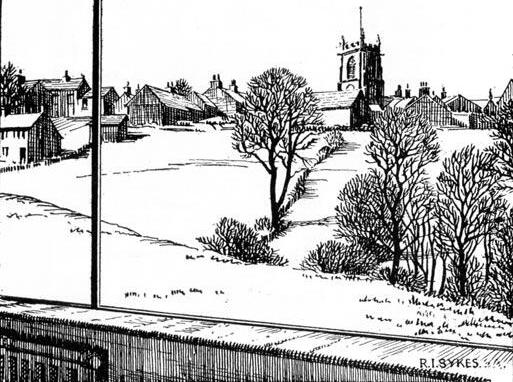
Sadly this pleasant, airy room is no longer used for teaching Art: several years ago, it was divided into two classrooms though the picture window survives.
The ‘blank factory wall’ is actually a wall of the 2,000 square foot Teaching Block built, along with a 6,000 square foot Design Block and the 5,000 square foot Sports Hall, in 1979/80.

There are still aspects of life in America that baffle our correspondent after over 40 years in the country. For starters, why are Americans so obsessed with guns?
AFTER more than four decades of living in The Land of Opportunity I’ve somehow avoided becoming fully Americanised. Technically, that would require passing a US citizenship exam. While several British expat friends have made that choice out of means-tested pragmatism, I haven’t yet been tempted to make the leap. Even so, despite decades of acclimatisation there are still a few national quirks that I haven’t been able to wrap my head around. Top of the list is the American obsession with guns. In May 1968 the National Rifle Asso ciation’s print mouthpiece American Rifleman published the ar ticle “Happiness Is A Warm Gun” (a perver sion of Peanuts car toonist Charles Schultz’s then-pop ular phrase “Happi ness Is A Warm Pup py”), inspiring Beatle John Lennon’s ironic song of the same name. In a cruel twist, twelve years later Mr Lennon was shot to death in New York City by a psychologically damaged man who should never have been allowed access to a firearm. Personal shock and

anger at America for allowing such a senseless murder to happen came close to derailing my planned emigration. Like most nippers of a certain age I grew up watching TV westerns and playing cowboys’n’injuns, packing a toy six-gun that fed on paper rolls of gunpowder caps instead of bullets and shouting “Bang, you’re dead!” In rowdy saloons and outside on main street, cattle rustlers and bank robbers got their comeuppance as stalwart marshals and trusty deputies meted out justice, sorting out the good guys from the bad based on the colour of their ten gallon hats. Unfortunately presentday America sometimes resembles a throwback to that unruly wild west era, only worse.
Rifles and handguns were commonplace at a time when huntin’ and self protection were considered paramount to survival, not to mention useful for seeing off interfering British soldiers. In 1783 the American colonists won their hardfought independence from British rule and, after much debate, their representatives hashed out the influential

U.S. Constitution. Introduced thereafter, ten supplemental provisions known as The Bill of Rights served as guarantees of citizens’ civil liberties. The Bill’s Second Amendment addressed The Right to Arm Bears… or, rather, to Bear Arms: “A well regulated Militia, being necessary to the security of a free State, the right of the people to keep and bear Arms, shall not be infringed.” This specific language would, in later years, limit the federal government’s ability to regulate gun ownership. The Tenth
Amendment hampered it further by allowing individual states to write their own rules, leading to the current situation where the nation is now awash with weapons. The Founding Fathers couldn’t possibly have imagined a future in which schoolchildren could be being mowed down in classrooms with rapid-fire assault weapons. Millions of words have been written both for and against revising the Second Amendment, and I have nothing revelatory to share that hasn’t been said before. The statistics, however, are sobering. There are estimated to be over 450 million guns in the US. No wonder Russia and North Korea have resorted to nuclear sabre-rattling: they’re aware that a land invasion could easily be repelled by well-armed American grannies and children. Bookshop shelves regularly display at least 20 different testosterific lifestyle periodicals with names like Guns and Ammo, Gun World, Combat Handguns, Recoil, Ballistic, Tactical Life, and Personal
Defense World to name but a few. During the Covid-19 pandemic, with fear and paranoia escalating, nearly one in five new households purchased a firearm. I really don’t understand why. I’d assumed viruses were bulletproof.
Gun manufacturers continue to abnegate responsibility for their part in gun crimes, the illegal gun trade, or shootings of any kind. The federal Bureau of Alcohol, Tobacco, Firearms, and Explosives (ATF) –yes, there is such a department – estimates there are approximately 80,000 licensed firearms dealers and 5,000 annual gun shows nationwide. The Protection of Lawful Commerce in Arms Act, passed by Congress in 2005, granted the manufacturers and retailers immunity against civil litigation. A conservative-leaning Supreme Court even shot down the Brady Handgun Violence Protection Act, waiting-period legislation named after the White House press secretary James Brady who took a bullet for President Ronald Reagan during a 1981 assassination attempt. This year the US took a step in the right direction by fi -

nally demanding background checks for all customers making purchases at gun shows and online. But why would a criminal, or even someone seeking anonymity, submit to that indignity when they can build an untraceable g un at home from a kit or a 3-D printer? Mass shootings, defined by The Department of Justice as involving four or more victims, now occur almost daily in America, with more than 170 reported in only the first five months of this year alone. Schools, stores, and workplaces seem to be the most popular targets. But
There were 604 ‘mass shootings (defined as shootings when there were four or more victims) in the US last year. In 604 shootings, 2,443 people were injured and 754 killed (Source: Wikipedia).
the real issue is the National Rifle Association’s willful misinterpretation of that annoying Second Amendment: the Framers of the Constitution lived in an era of wildly inaccurate flintlock muskets, rifles, and cannons, not rat-a-tat semi-automatic Glocks and AR-15s. Many legal gun owners, mostly on the political Right, maintain an irrational fear that Democrats are threatening to take away their beloved weapons. It’s an exaggerated concern fired up by heated NRA rhetoric, arguing that only good guys with guns can stop bad guys with guns. That doesn’t explain why more than half of gun-related deaths – over 43,000 in 2023 – were suicides, not homicides, according to the non-profit Gun Violence Archive. Instead of offering protection, the presence of a gun in the home increases the risk of household fatalities.

carnage, the NRA instead cites killers’ mental health problems. Its deep member-funded pockets sustain a powerful gun lobby in Congress where big money holds sway. As long as excuses keep being made against tightening restrictions the killings will continue unabated. But wait, maybe the NRA is right after all in claiming guns aren’t the problem: it’s the bullets, silly! The savvy carnage-inclined shopper can get hold of incendiary ammo that ignites on impact, armour-piercing rounds, and fragmenting ‘butterfly’ bullets. Why anyone should need these things in their home arsenal is anyone’s guess.
The NRA and its adherents claim that arming classroom teachers and on-site security personnel* will prevent school shootings. Tragically, that’s been proven false. The immediate and longterm effect on children seeing their teachers and classmates murdered in what ought to be a safe environment must be devastating. Refusing to blame firearms for the
News outlets are doing Joe Public a disservice by censoring images of gruesome gun crime scenes, not wishing to offend our delicate sensibilities. If anything, it de-sensitises the viewer… not to mention the policymakers in government. It’s like they say, if slaughterhouses and factory farms had glass walls people might think twice about eating meat. n (*King James’s had Dave Bush, so we didn’t need armed security.)
by Hérisson
Entries to the Editor (address/email: back cover) by 30th September 2024. Prize: 12 months’ free OAS membership

1. Headless rodents, 8 perhaps, in the drink. (3,4)
5. State ‘fungi returned’ provided you start. (7)
10. Concentration aid used in Roman tradition. (6)
11. Bypass balls, see. (8)
12. I leave Rick Stein confused and afflicted. (8)
13. Try to hold one pound on your head, maybe. (6)
14. It’s before your very eyes. (9,6)
16. Locked up, about to send back –and not a moment too soon. (2,3,4,2,4)
20. He composed vodka cocktail round Russian leader. (6)
22. Film entry I changed forever. (8)
23. Superior chopped tarragon. (8)
24. Not very much left in vision. (6)
25. Brew got up in the garden. (3-4)
26. Innocent without pictures. (7)
l The winner of Crossword by Hérisson (March 2024) was Keith Sykes (1956-63)

2. Dreadful charade prevents exact reference. (7,3,5)
3. Stick an arrangement that might grow on Hazel. (7)
4. Jet’s pale bird. (5,4)
6. Fold crushed petal. (5)
7. Castle – not new. It is in Cadiz evacuated. (7)
8. Sport agrees with games. (8,7)
9. Set piece in 8. (6)
15. Anglo-Saxon King Edward,not against, but for academic. (9)
17. Supporter back in time for shelter. (7)
18. Make meandering trace to East. (6)
19. Unusually lenient illustrator. (7)
21. Skate around poet. (5)
People laugh when I say music’s a drug, but it has been such an important part of my life for the last 60+ years that there must be something there. And I really couldn’t live without it…
IT started with my mate Hugh Lawson when we were in the fifth form.
I remember hot summer days in his garden, playing Brahms’ Hungarian Rhapsody on a wind-up gramophone time and time again. Hugh played the cornet in a youth band in Elland, and he took me to a rehearsal. Just about the only time in my life when music didn’t come first was that occasion; I remember putting off that visit until the week after I had sat my ‘O’ levels (GCSEs).
They lent me a euphonium and a tutor book, and I was hooked. I got into the band in two weeks and was principal euphonium within four months. I was so keen that in the sixth form I would take the euphonium to School and practise in my free periods, in the music room just over the head’s study. Harry Taylor must have been very tolerant!
I was noticed. George Beach (Head of Maths, but a polymath) conducted the School orchestra, and he was worried because the only double bass player in the School was
about to go up to uni, so would I like to take up the double bass? It seemed a reasonable idea.

Before I go on, I should make clear that my brass band career didn’t end at this point. After EllandYouth Band I played with Meltham & Meltham Mills, and then started helping with the Huddersfield Youth Brass Ensemble, the brass band of the HuddersfieldYouth Orchestras. In January 1970 their conductor dropped dead, and I was asked to keep it going until a new brass peripatetic was recruited; conducting the band went with the full-time job. I had married Gillian a few months earlier, a music teacher I had met in the band. She applied and got the peripatetic’s job, and graciously allowed me to keep on conducting. She taught the pupils and did all the organising; I conducted, bowed and took all the glory – an excellent partnership! Though to be fair, I was just a trifle busy building accountancy practices. We don’t need to go there.
But this youth band be-
came very important to us. With political and financial pressures we couldn’t continue as a town youth orchestra, so we took it out, formed a charity, had a powerful parents’ committee, and flourished. Gillian arranged 21 concert tours for the band, to many European countries and latterly to Canada and USA several times each. We were on BBC’s Songs of Praise, we played for the Queen and several other royalty, at the biggest Highland Games in the world (at Fergus, Ontario), Niagara Falls, and our last tour in 1996 was to Disney in Florida (concerts in Magic Kingdom and Epcot) and the NASA Space Center at Cape Canaveral, finishing in Charleston SC. How did we do it? That drug called music, of course!
Back to the double bass. So at 17 I embarked on a new venture. The ’cello peripatetic John Hanson gave me lessons, and in no time we would spend the lessons playing duets. I got into the Huddersfield Junior Youth Orchestra (there were five graded orchestras) and within a year I was in the Senior Orchestra. I took my Associated Board exams, and in adjacent sessions I passed Grades V, VI and VII (the final in
those days) with a very neat set of distinctions: 132, 134 and 136. And, to my delight, because the Music Department (now the music faculty of the University of Huddersfield) was only a small group of students, to play the larger symphonic works they augmented by using people like me. I had the privilege of playing fourth double-bass of four, the others being full-time music students and very capable – what a delight!
It got better. In 1962 we did a concert tour in Southern Norway and played some heavenly music. I particularly remember a sacred concert in Mandal Church, and a broadcast concert in Kristiansand cathedral.

The LSO is rather special. Founded in 1890, it is one of the oldest amateur orchestras in the UK (I wasn’t a member at the start, though I am the longest-serving member now!).We have had 10 conductors, some only briefly during war years, but Martin Binks MBE served from 1970 to his death in 2019. He also conducted West Riding Opera, with whom I did 40 productions. Our current conductor since 2020 is John Lyon, a violinist and teacher from Sheffield, who is wonderful at sorting out the details with us in rehearsals, and then putting on truly memorable performances. He also conducts Leeds Youth Opera and several other groups.
John Hanson took to me, and helped a lot with my playing. He collected ‘cellos and double basses, and lent several to me in turn.Then he found me a beautiful instrument, made in 1887, which cost £50. I still have it, and play it all the time. Believe it or not, it is now worth £80,000!

After a couple of years playing with the college orchestra, I joined Leeds Symphony Orchestra. So did Gillian; she played the French horn, and whatever else was
Concentration: Chris Makin is on the right Also shown is Julian Ridge, current chair of the Leeds Symphony Orchestra.
happening in our lives, we always managed to attend rehearsal on Monday evenings. How did we do it? That music drug again.
After a few months, I was appointed principal double bass, a post I held until September 2023, well over half a century. At the age of 80 I’m not the player I was. When our new principal bass joined, I introduced him to the orchestra by saying that it took you lot half a century to find a player better than me, and it wasn’t a very high bar!
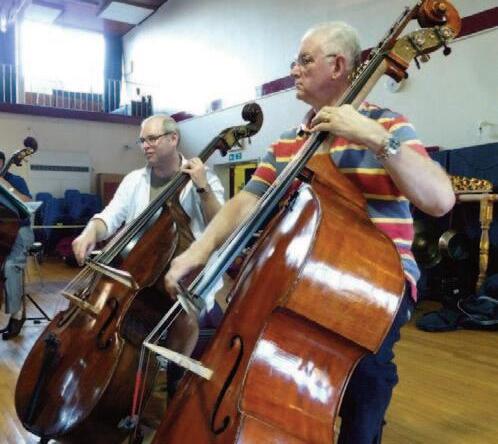
So how has the last half century been? Very interesting, and very rewarding. We normally do eight concerts each season, so I must have played in about 400 concerts. Each would typically comprise an overture, a concerto, perhaps a suite and then a symphony. I’ve played all the Beethoven symphonies except the Ninth, the Choral; that was seven years ago, and I missed it because I was busy having a triple by-pass. Under Martin Binks, our conductor for 48 years, we played a great deal of French music. But really, we have played a huge variety, including the SaintSaens Organ Symphony, the Richard Strauss Alpine Symphony, Moussorgy’s Pictures at an Exhibition, and so on. Now with
our new conductor John Lyon we are quite adventurous; as an example, the other Saturday we played a finished version of Schubert’s Unfinished Symphony, the Richard Strauss Four Last Songs, and then the Janacek Sinfonietta, some of the most difficult music I have ever been asked to play. It requires a huge orchestra, and as well as the usual brass section we had 11 more trumpets, 2 valve trombones and 2 euphoniums. Talk about a wall of sound!
If you want to hear what we sound like, go to YouTube and LeedsSymphonyOrchestraNimrod. This is one of those pieces we did individually at home during lockdown. It worked!
What next? Well, our next concert is in St Margaret’s Church, Ilkley on Saturday, 6th July. It’s mainly an Italian programme to suit the summer weather (we hope) so we have the Tchaikovsky Capriccio Italien, the Berlioz Roman Carnival overture and Respighi’s Pines of Rome. In and among will
be the première of David Baker’s violin concerto. David is principal bassoon in Opera North and a good friend of the orchestra. He composed the concerto during lockdown when he was on furlough. We were going to play the piece some months ago but then, would you believe, the soloist came down with Covid! It should be quite an evening. We are hoping that members of the Old Al-
mondburians may wish to join us, at a special ticket price of £10.We will have a meal in The Lister Arms in Ilkley (LS29 9LB) at 5.00 pm, and I plan to give a brief, but not very learned, pre-concert talk. Full details of how to join the party are given in the panel below.
Come along, and you may understand why music has been such a drug throughout my life! n

LEEDS SYMPHONY ORCHESTRA
TCHAIKOVSKY Capriccio Italien BAKER Violin Concerto (première) BERLIOZ Roman Carnival Overture BELLINI Oboe Concerto RESPIGHI Pines of Rome Violin Andy Long Conductor John Lyon
Saturday, 6th July 2024 at 7.30 pm l St Margaret’s Church, Ilkley Convene at The Lister Arms, Ilkley at 5.00 pm for meal/drinks followed by pre-concert talk by Chris Makin (KJGS 1954-61 / LSO double bass) Concert tickets: discount price £10
To join the party, email summer-reunion@oas.org.uk, text LSO to 07815 601447 or complete the special form on www.oas.org.uk/summer-reunion.php.
ONE of the saddest aspects of old age is to hear regularly of the death of one’s contemporaries. To save you time working out my own age, I’ll inform you I shall be four score years and five in September. From any stand point, it is a goodly figure and I have no intention of shuffling off my mortal coil any time soon. My confidence is boosted by my latest ‘Prostate Specific Antigen’ (PSA) readings. For the last four times they have been at less than 0.1. In consultation with Velindre Cancer Hospital in Cardiff, I was elated for a moment when I was told that, if this continued, my hormone therapy injections could cease in November 2025. I do hope this happens as – predictably – I do suffer from

side effects, especially fatigue. (My family constantly remind me that the effects of Anno Domini are most probably greater). I trust, dear reader, that you will forgive my somewhat self- indulgent update but not being a user of social media, it is the easiest way to respond to all those kind souls who have followed my treatment. And I say again, to all you males out there, get yourself tested. Caught early it is eminently treatable! ( exclamation mark justified)
Eric Abbott
This opening paragraph was prompted by my reading in the last magazine of the death of Eric Abbott (1958-63). Eric never uprooted many academic trees but

to me he was special in a number of ways. In the pupil record cards stored in my room for many years ,Abbott, Eric was the first one. When the School began to admit pupils with Asian backgrounds, Eric lost his place. I remember that the only comment on his card was a note written by Harry Taylor, Headmaster, which said ‘Missed Founders’ Day Service’; that says so much in so few words.
My first encounter with Eric was during my teaching practice at KJGS in November,1960. It was during a Latin lesson in D4, now a staff workroom, I believe.
My tutor from Leeds University Education Department was there. I had occasion to send Eric out of the room. No idea why. At the end of the lesson the tutor said “You were quite justified in sending that boy out, Mr Bush, but you should have made sure
he took his textbook with him so he could have continued his work outside the room.” How out of touch with reality! I cannot recall ever sending a pupil out of the room in the rest of my career but someone may come up with another name. After leaving School, Eric joined the Old Almondburians’ Football Team and I enjoyed playing alongside him and admiring his languid style. I like to believe we became firm friends.
My ‘close encounter’ I was delightfully surprised by the number of readers who expressed their enjoyment of my recounting our close encounter of a murderous kind in Northern Scotland in the last Almondburian. It has been suggested I might write more on a similar theme.

Some of my birding trips to exotic locations brought scary moments and ones in Nepal and Guatemala spring readily to mind. Closer to home, in the south of France to be precise. In April 1999, occurred an incident when Margaret and I were convinced we were being targeted for a robbery. I’ll let one of the two ‘assailants’ recount her version of the hold up taken from her daily diary.
‘ … As we reached the roundabout to Bolene, we paused and suddenly spotted Dave and Margaret in their car, coming towards us. Ken did a quick turn and with horn tooting and me waving both arms, we pursued them until they stopped obviously thinking they were about to be robbed, until we raised our helmet visors and said ‘Bonjour M’sieur et Mme Bush and they were stunned.We had hoped to surprise them but this could not have gone better. Dave was lost for words and once Margaret had got over her shock, we had a great reunion on a road in the middle of Provence.’
In a rut?
And so to matters more meaty. I am not referring to Town’s relegation or The Imps just missing out on the playoffs.( This means , of course, that next season I can look forward to an Imps v Terriers clash.)*
Now, when it comes to tradition, then there are no more hardened traditionalists than Dave Bush and Jack Taylor. This topic has originated from the debate about dropping the ‘Old’ from the Society’s name. I had a long telephone conversation with Jack recently and what a delight that was, Jack being as sharp and humourous as ever. Inevitably, we discussed the proposed name change. Both of us are firmly in favour of CHANGE . I capitalise that word as we fully agreed that it’s not only the name that needs to be altered but some fundamentals.
We knew Ken Leech (1947-52) and his wife Janine were touring southern Europe and were in that area but thought the chances of meeting up were remote. Ken and wife were frequent visitors to the School when visiting the UK from Australia. (My granddaughter Anna and I visited them in Melbourne in April 2000, and Mike Powner (1959-67) and his wife, who have relatives in the area, are frequent visitors . All thanks to our Society.)
I don’t consider that it is particularly important if the name is changed or not; I see it more as a symbol of intent. Margaret ever queries why, after nearly twenty-eight years of retirement, I still feel so strongly about matters Almondburian. Put simply, School and Society occupied an enormous amount of my working and leisure time and I cannot ignore what I see as serious signs of future decline.
*Huddersfield Town FC were relegated from the Championship League to League 1 at the end of the 2023-4 season.

To be blunt, the Society is in a rut. Each year, it’s the same round of activities attended by much the same small group of members. Let’s take my great love: Badminton as an example. Here in Porthcawl, we have had at times a waiting list of se nior players while up to twenty juniors are coached by four or five seniors before their session. Espe cially with a more local intake, surely this is a possibility at KJS. There must be a golfer or two among the School’s population as well as tennis players. Can Year 11 not submit a quiz team? In summary, the Society must seek more ways to involve the School.
As for the Annual Dinner, I have even stronger views here. Space and potential eye-rolling prevent my elaborating at great length (is that tautology?) but the idea of family
Difficulty: easy
Each row, column and 3 x 3 box must contain the digits 1 to 9
groups, price reductions for recent leavers, buffet meal, encouraging individuals to persuade small groups to attend, and inviting special surprise guests. I have submitted my idea to Chairman Walter of how to recruit Year 11 leavers.
I am aware that the last paragraph has been a ramble but it represents some of my diverse thoughts on how the Society should adapt and particularly how its future depends on tightening links with the School.
The Almondburian
I always try to end my article on a positive note. Amid my largely gloomy submission one beacon shines out. Thank goodness for The Almondburian . It cannot be bettered by any former students’ association both in the public or private sector. n
Floreant Schola et Societas
THIS poem appeared in The Almondburian in July 1941. These were the darkest days of World War II but the Editorial of the same issue provided a welcome reassurance that the School was facing the challenges ahead with grim determination:
In spite of war conditions the life of the School continues, and in one way or another we are keeping alive all our main activities and adding new ones which the war itself has called forth, such as the ATC [Air Training Corps] and digging for victory. Nor must we forget our school savings group and our weekly collection for various war funds.
Austin Holroyd - who was 14 when war broke out - clearly retained memories of what life was like in those wartime years. He was no doubt comforted by his parents who had been though all this before in World War I − when Germany was still ruled by its final emperor Wilhelm II, ‘Kaiser Bill’.

Austin Holroyd (KJGS 1936-41) was a longstanding member of the Old Almondburians’ Society who often gave talks to pupils about the School in the days of Taylor Dyson. in 1946, he joined a small foundry in Huddersfield Crowther & Gee Ltd and in due course became its owner. The company was sold in 1986, at which point Austin joined forces with his son and a friend to set up a rubber mouldings company, Huddersfield Polymeric which was sold on Austin's retirement in 1992. He had a lifelong love of sport and played golf at Woodsome Hall where he was club captain in 1986.
Austin died in 2010.
l There is a fascinating interview with Austin Holroyd on the OAS website at www.oas.org/uk/www.oas.org.uk/audio1.php
When for a walk we went at night, In winter when it was not light, And street lights shining down were bright — Remember?
When we could spread the butter thick? Whipped cream and chocolate we could lick; With eating sweets we oft were sick — Remember?
When we had steaming Irish stews (Before the butchers’ were no queues); And sports events were in the news — Remember?
When we had rashers of fried ham, And jars of every kind of jam. Huge roasts of beef, and nice cold lamb — Remember?
When we went off with ma and pa On sunny days before the war, With lots of petrol in the car — Remember?
When the last ’bus was really late, Before the Luftwaffe showed its hate… (Those holidays we had were great) — Remember?
And in that Great War things went hard, When Kaiser Wilhelm the world marred, But Britain held the winning card — REMEMBER?
A F Holroyd (5L)
QUIZ NIGHT 2024
‘The 1960s’ team hoped to make it four in a row – but it was not to be as they faced unexpectedly stiff opposition from their younger rivals.
THE Woolpack in Almondbury was the venue once more for our annual quiz. The downstairs public bar was showing an important Premier League game, what could be a title decider between Tottenham and Manchester City, but the Almondburians’ focus as they made their way to the upper floor was on challenging for the Quiz Trophy.
‘The 1960s’ team were bidding for their fourth successive win and welcomed back key member, David Sinclair. However, previous winners ‘The 1970s’ had returned to compete and were determined to make life difficult for them – as were the other four teams: Badminton, The Reserves, Thorpe Lane Warriors and Quizteam Aguilera.
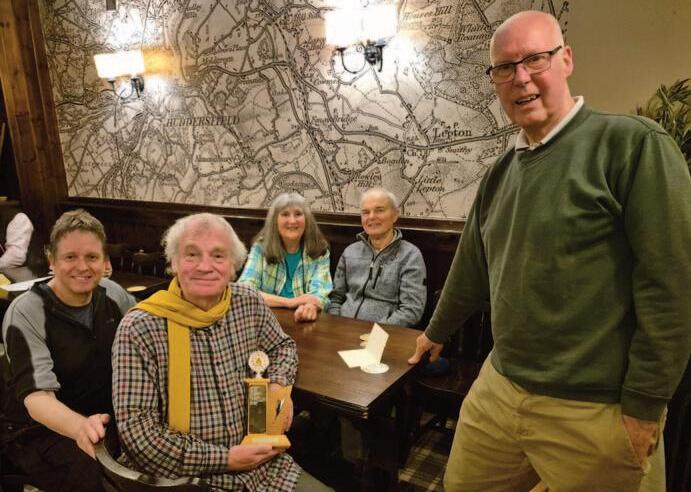
Keith Crawshaw, our esteemed quizmaster, had installed himself in the corner of the room and we expected another challenging set of questions. He was ably assisted by Charlotte Haigh distributing question sheets. The usual ten round format was explained by Keith, including the buzzer rounds (without buzzers).
Round 1 was ‘6 are not’: eliminat -
ing 6 items from a list of 16 to identify the events in the Men’s Olympic Decathlon, characters in Dr Doolittle, and books in the Bible New Testament. Most teams performed well on the Decathlon and Bible but memories were hazy on Doolittle, mainly drawing on the Rex Harrison 1960s film.
Round 2 was ‘English Heritage Sites’. A map of Yorkshire and border -

ing counties had 15 numbered locations to be matched with a list of 15 English Heritage attractions. Difficult – could you locate Roche Abbey and Spofforth Castle?
Round 3 brought us into more traditional quiz round territory ‘Faces’: a photocopied sheet of portraits of 16 ‘celebrities’ recently in the news. These ranged from the obvious Martin Lewis, to the more difficult Cameron Norrie and the obscure Colin Graves of Yorkshire CCC.
Round 4 was ‘Buzzer Style A’: a range of ten general knowledge questions with wrong answers leading to point deductions.
And so to Round 5 , the last round in the first half: ‘Price More or Less’.
A knowledge of the television shopping channels and the throw-away supplements in newspapers would have been useful here. Ten garden items had to be identified as more or less expensive than £35.
A refreshment visit to the bar revealed the half-time football score to be 0-0.
Of more importance, before moving on to the quiz second half, Keith informed that ‘The 1970s’ had opened up a narrow lead.
For Round 6 ,‘Musical Numbers’, Keith produced a vintage boom box and played a series of music excerpts from pieces with a number in the title. The easy ones were ‘24 hours from Tulsa’ and ’76 Trombones’, but others were met with blank looks.
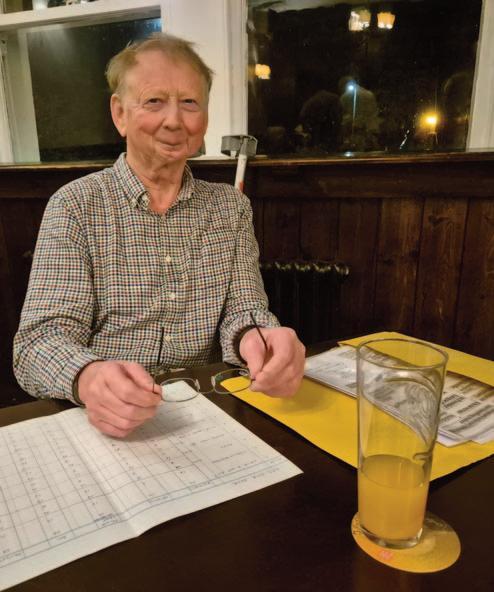
A ‘How Sweet’ Round 7 followed, taking us back to our sweet shop days. Cryptic clues were given for old favourite treats. I think we all named Gob Stoppers from the clue Mouth Plugs.
Round 8 was ‘Buzzer Style B’. Another range of 10 general knowledge questions like ‘How many players are there in a volleyball team?’ We wavered between 4 and 5, but it is, in fact, 6.
Our flagging spirits were lifted once again by a picture round Round 9 –‘Prey? Out for a Duck’. 12 coloured photos: 6 of birds of prey, 6 of ducks to match to 12 names. There were some obvious choices but when you get ones
The man with all the answers: genial quiz inquisitor Keith Crawshaw
wrong it can lead to a domino collapsing effect.
Round 10 was the final one. For ‘Missing Words’ we all wished we had read the Yorkshire Post in April and May (as Keith obviously had). The format, well known to viewers of Have I Got News For You , was inserting words in the blanks of newspaper headlines such as ‘William and Kate celebrate nnn anniversary’? Was it 12th or 15th? No, it was 13th.
The final scores showed a significant gap had opened up between the winners ‘The 1970s’ and the runners up ‘Quizteam Aguilera’; they, in turn, were closely followed by ‘The 1960s’. Last year’s champions had been deposed in our quiz but the score from the bar, 2-0 to Manchester City, suggests the latter’s will continue.
Walter Raleigh presented the trophy to ‘The 1970s’ and thanked all competitors for their attendance. It’s not the winning it’s the taking party that matters and we all agreed it had been a very enjoyable night. Keith received a welldeserved round of applause. n
When we organised a ‘Democracy’ event in March, we didn’t know that a General Election would be held in July. So now we’re holding our own in School, reports ABBI TERRY.
For this issue, I have had a lastminute change of plan to my theme. Originally, I was going to talk about student leadership but as there will be a General Election by the time you read this piece, I have decided to focus on the election and how we will be marking it in School.
It’s quite tough being a politically minded teacher. I do have very strong thoughts and opinions about politics and how I think things should be done in this country. I watch the news, listen to political podcasts and we often debate current affairs while having our evening meal at home.
Even so, I do try my very best to follow the guidance from the Depart -

ment for Education who state that “the law prohibits the promotion of partisan political views in teaching. Schools must take reasonable steps to ensure that, where political issues are brought to pupils’ attention at school or school extra-curricular activities, there is a balanced presentation of opposing views.”
It can be tough at times, especially when students ask me for my views and whom I support; but I have got used to avoiding the question so that my own stance is not transparent.
While I won’t be drawn on whom I am backing, there is one thing that I do feel very strongly about and something that I will share openly, and that is the proposal for lowering the age of voting to 16 or 17 years old.

Time and time again, I hear that young people do not know their own minds but I can tell you as a teacher of 20+ years that this could not be further from the truth. Yes, some young people do simply repeat what they hear at home and so are biased based on what
their own families argue. But give them the opportunity to explore, discuss and question what is happening in the world and the area around them, and many of them can be incredibly astute and mature in their outlook. They do have their own minds and they are capable of deciding what they believe and who they would like to be in power.
This was confirmed to me recently when I worked with Conscious Youth which is an organisation based in Huddersfield. We held a ‘Democracy’ event where Year 9 students explored budgets, funding, policies and manifestos. The most eyeopening part of the day was when the young people were creating their wish list for the future and they included ideas such as everyone being treated the same, no one being judged, everyone having the same chances as everyone else and wanting to help those who are vulnerable.
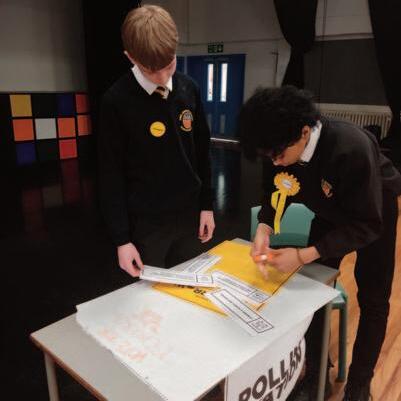
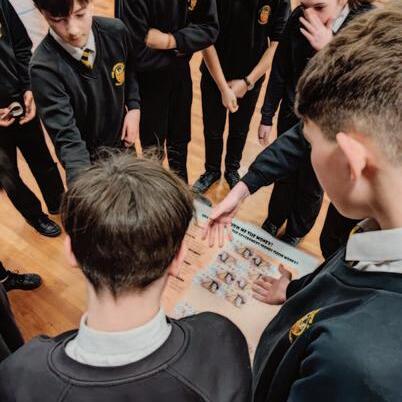
This made me feel good about the future because the students recognised that they simply want a better future for everyone, no matter who they are. I think we have a safe set of hands in the next generation.
But what about in School? We will be holding our own General Election in School on Thursday, 4th July 2024. In the weeks running up to the election, I will be sharing the key policies
and manifestos of the main political parties with students so that they can see what each party actually wants for the future. The hope is that our young people can consider what they stand for, without the scandal, mudslinging, and political point scoring that will no doubt be prevalent in the run up.
I think a lot of our politicians could potentially learn a lot from the maturity of our young people! n

ON 8th March, International Women's Day, 12 Year 9 students visited the University of Huddersfield for a Women in STEM day. They heard lectures on a number of engineering topics followed by a tour of the Laura Annie Wilson Building where they could see engineering machinery in action. They were also shown around the ‘Smart House’, a two-bedroom house to facilitate research and development for smart goods and services in a built environment.
Agroup of 14 Year 9 pupils were able to ‘Go Ape’ in a visit to Temple Newsam, Leeds on 15th March. Go Ape trips are designed to promote physical and mental health, building on self-confidence and resilience by providing challenges that excite and encourage personal growth.
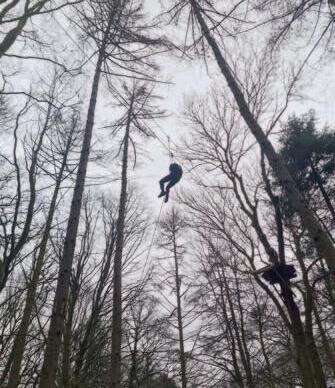
The students took part in the ‘Treetop Challenge’, the most popular treetop trek. Claimed to be ‘a real mecca for thrill seekers who love canopy high trees-to-trees crossing, free-fall Tarzan swings and riding super-fast, very long zips’ the Challenge is made up of 17metre high platforms and 13-metre plummets, with zip lines up to 60 metres long. According to reports, all students were a credit to the School and showed real team spirit. Pupils were well out of their comfort zone and found the Challenge a valuable experience.
BIG congratulations to the Year 10 netball team who have won the Kirklees league, fighting off strong competition in the final against Shelley College. The final score was 1513. The girls made us very proud with their hard work and effect.
Left to right: Tarleen Aujla, Ruby Moss, Isabel Holden-Rowley, Florence Jones, Macey Blakeley, Ava Wike, Carys Coldwell.


And in short…
ON Wednesday 13th March, nearly 30 Year 9 students took part in a ‘Democracy’ event organised by Conscious Youth, a Huddersfield-based organisation set up in 2016 to build the self-esteem and self-worth of young adults by changing their outlook on life, by broadening their horizons and helping them to empower themselves. The objective is to enrich the lives of young adults through mentorship, sports, arts education, cultural exploration, health & wellbeing and public service.
Full report: ‘Classroom Commentary on page 44.
l Year 7 students took part in KirkleesWorld Book Day Quiz on 7th March, working through a reading list of 20 titles in 6 weeks.
l Students across the School tackled a range of mathematical teasers on 3rd March to mark Pi day.
l At the end of Winter half term and linked to the Chinese NewYear, 105 mathematicians from acrossYears 7-10 took part in a mega-multiplication challenge. Using the ‘Chinese Grid Method’ they had to work out 3,224,891 x 10,234,050. There were 33 correct answers [3,003,695,738,550].
KJS produces a lively full-colour Newsletter each term. If you would like an email copy please contact Tracy Sykes (Reprographics): Staff.TSykes@kingjames.school.
ROBIN MERCHANT
AS you will know from the last issue of The Almondburian the Gothard Cup 2024 competition is scheduled to take place at its traditional venue of Woodsome Hall on Sunday 21st July. As all you golf fans will probably know, this is also the date for the final round of The Open, being held this year at Royal Troon.
robin.merchant@oas.org.uk not only for our own competition but also to watch that other great golfing event. The golf there may be of a slightly higher standard, but the banter will definitely not!

We have therefore decided to bring our tee-times forward to 1.00 pm. This will enable all to enjoy a drink and watch the conclusion of The Open before our celebratory meal and presentation of prizes.
I do hope you will be able to join us,
And don’t forget if you don’t play golf regularly but might wish to take the game up, I have arranged with the Woodsome Hall golf professional a taster session on the day!
So please email me without delay if you would like to attend Gothard Cup 2024 – and perhaps also enjoy a taster session – so we can make the necessary arrangements with Woodsome. n
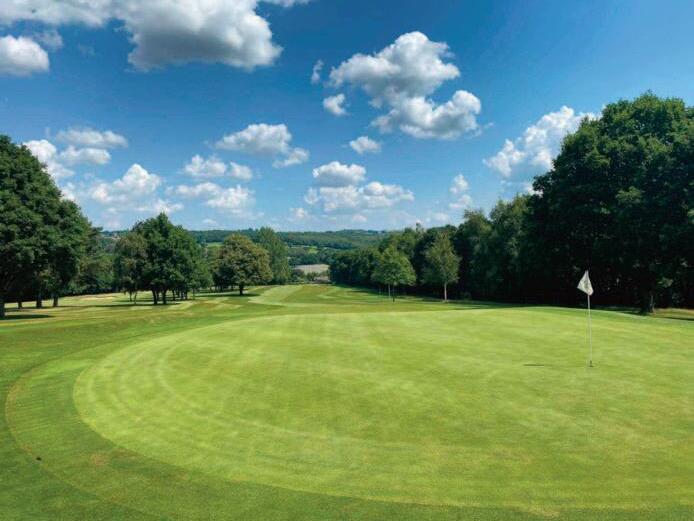
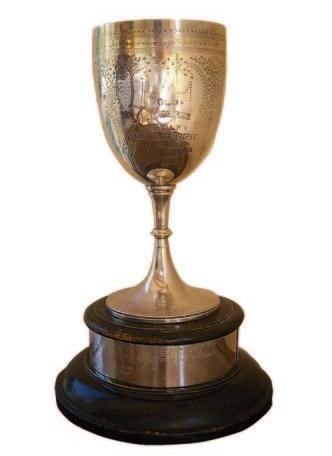
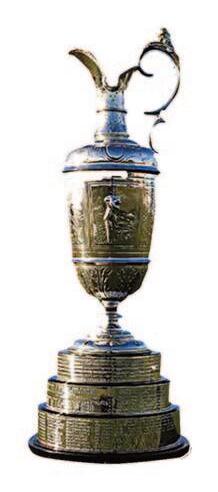
ANDREW HAIGH andrew.haigh@oas.org.uk
THE 2023/24 badminton season saw a very early finish this year, with Easter falling at the end of March. This meant that School closed for the holidays on 22nd March, but in fact the badminton season was curtailed a week earlier, due to G.C.S.E. exam papers being on site ready for the exams straight after the holidays. As a result, our final evening of badminton was as early as it has ever been this year: Thursday, 14th March.
The penultimate week of badminton was also rather eventful. Some of us were still playing, whilst others had gone for an early shower, when the fire alarm sounded. A fire engine duly arrived and, following an inspection of the premises, the fire officers decided that steam in the changing rooms had triggered the smoke detector, so they went home, satisfied that there was no fire. The alarm was still sounding, so I telephoned the premises manager in order that he could talk me through re-setting it. By this time everyone else had retired to the Conservative Club. I briefly considered going to get my own shower, before deciding the better of it, in case the whole cycle started again! The fire alarm system is new and had only been commissioned a few weeks earlier; subsequent checks found that the smoke detectors in the changing rooms

were on too sensitive a setting in error. This has now been rectified and so it shouldn’t happen again, although why showers in the previous few weeks hadn’t uncovered the problem, I do not

We shall look forward to reconvening for the 2024/25 badminton season in the School sports hall on Thursday, 5th September. We play from 7.30 pm until 9.00 pm, or until the fire alarm sounds, every Thursday during term-time, so why not come along and join us?
In view of the early finish to the badminton season, the tennis season started correspondingly early on Thursday, 21st March. Once again, we are using the facilities of Longley Community Sports Club and we have teamed up with some Longley members to augment our numbers. There are usually plenty of courts available on a Thursday evening at Longley, plus an indoor court, should the weather be inclement, so please come along and join us.

There is a guest fee of £3 per week payable by anyone who isn’t a member of Longley Community Sports Club. We shall be playing on Thursday evenings from 6 p.m. until 8:30 p.m. and afterwards we retire to Almondbury Conservative Club for refreshments. n
From: Allan Dobson (1947-52)
Some years ago when I proposed
‘The School’ at the annual dinner, I referred to the very wide range of ages of those present, and that we older members must have appeared as dinosaurs to the head boy and girl. I made the point that no matter, we were all Almondburians and that every person who had attended the school became an Almondburian the day they first arrived and remained so for the rest of their lives. Therefore, I believe that the society should change its name in recognition of this.
If it is accepted that one becomes an Almondburian on entering the school rather than on departure, then the opportunity arises to sow this idea in the mind of young arrivals and emphasise it during their stay and again on departure. Perhaps this could be done by giving each new pupil some form of memento (certificate, badge) to
From: Prof Colin Robson (1946-53)
YOU ask in the March issue of The Almondburian for views about a change of name of the society to ‘The Almondburians’ Society’.
From:Terry Green, CBE (1947-54)
Iindicate that they had automatically become a free member of an association of some 400 members. Perhaps the society could sponsor this memento which could be presented at a formal assembly very early in the new school year. As we know, the young people now depend on social media for communication, so it may be possible, subject to all the various regulations, to obtain contact details and tweet, WhatsApp, Facetime (or whatever it is called) an annual message to each subscribing (non financial) pupil just to remind them of their exclusive status as Almondburians with a special message at the point of leaving the school perhaps accompanied by another small memento.
I hope this provides a useful contribution to this important discussion at such a critical time.
Brighouse,WestYorkshire
I am fully in favour of the change, and urge its adoption without delay Combe Down, Somerset
strongly support changing the name of the Society to ‘The Almondburians’ Society’.
Upton, Chester
THANK you and the OAS for continuing to send me the magazine, which always makes an interesting read. While I’ve been a member for a long time, I’ve not really done ‘my bit’ to get involved and support the OAS, until now. I was compelled to do so by the call to action regarding the proposed name change, but potentially could do more still.
I consider myself exceptionally fortunate to have gone to such a wonderful school. As someone cited in the most recent magazine said, you don’t really appreciate the start that KJS gave you until you’re long clear of it. Unlike the majority of attendees at most of the OAS events, it seems, I was from the comprehensive era, but what a school and general environment to experience that time at! The buildings, the location, the traditions, the history, the quality of teaching, would all be to die for these days. I’m sure it’s the same at KJS now, of course, but certainly during my time there it was incredible, and I don’t think I’m seeing it with too much of a rose-tint.
Seeing Bob (..ahem,. Mr Field) on the Annual Dinner guest list brought back memories of French and PE, and the legendary Messrs Raleigh, Bush and Taylor certainly formed my memories of that time. In particular, Mr Bush was outstanding: I still
remember most of what he taught me in Classics and Latin because it was so inspiring to a sponge-minded individual. Unfortunately the sixth form closed before I could go, but in some ways that was a good thing. Greenhead College had a more adultfeel to it, which prepared me well for Cambridge thereafter.
So, to the chase. I support wholeheartedly a name change to The Almondburians’ Society, if it will unlock a younger membership. The name, in my mind, really isn’t a big deal; it’s the membership that counts. KJS’s values – through the staff and students of the time – need to continue to live on through rolling, refreshing cohorts of ex-students who remember their great times there, especially beyond the School’s grammar status. If there’s something I can do to help with that then please let me know. I’d love to say I’ll come back to Huddersfield for the Dinner in November (my parents still live in Lepton) but lives are unpredictable and so I can’t promise anything, but I’ll certainly try, in order to try to unlock a (slightly) younger audience. Every little helps, I guess. Memories matter, and school forms the bedrock of one’s life and outlook, and I’m delighted that mine was formed at King James’s School.
Henley-on-Thames, Berkshire
IN regards to the suggestion regarding the name of the Old Almondburians’ Society, I would support dropping the word ‘Old’ from the title, especially if there are concerns about attracting younger members.
No matter someone’s age, the assumption will be that the members would be from a previous generation and not for those who we do need to get on board.
Almondbury
I.recently attended a meet-up of the year of ’57 held in Nottingham. Unfortunately there were a few last minute cancellations and only six of us made it.
I mentioned the proposal to drop the term ‘Old’ which was supported.
While a few of the ’57 year attend the OAS Dinner most prefer the casual meetings held in Huddersfield or Nottingham etc about twice a year. The conversation seems to dwell on what we or the staff did at that time in the ’50s and ’60s. Many have attended the OAS dinner in the past but are either not members or don’t appreciate formal occasions.
I have attended the Dinner regularly since Gordon Kaye was the guest speaker and support the current format providing the speakers are advised on the length of speech expected.
I also support the short presentation by the Head Girl and Boy. As well as being informative it is an excellent development opportunity.
My personal circumstances are that I
I’VE been reflecting on your plea in the March edition of The Almondburian.
First and foremost I support the change of name to The Almondburians’ Society. One could even go a step further and replace the ‘Society’ tagline by ‘Association’ which sounds a bit less formal; maybe too bland perhaps but at least might appeal to those school leavers of the present era as it would
combine the Dinner with a visit from Cardiff to my sister in Brighouse. In the past I also included a game of badminton.
I have been a member of the Association of Speakers Clubs for many years including service on the National Executive as S.West England and Wales District President. Hence, I take a great interest in the material and presentation skills of the OAS speakers.
I accept that there is a chasm between the grammar School and the current establishment which is difficult to bridge given the different generations and cultural habits.
Whether there is scope for a more informal lunchtime event would depend on canvassing the current membership.
I support the idea of some sort of mentoring programme with Almondburians' involvement in the career pathway of students. This would appear to be a complex undertaking with the school hours restrictions these days compared to the many out of hours activities we participated in.
Rhiwbina, Cardiff
be a total breakaway from the 1940s - 1970s concept.
Elsewhere in the magazine there are several references to intakes from the above eras who have formed their own reunions entirely separate from the more natural and appropriate gatherings that come with the Annual Dinner in November. In some instances it has actually been stated that the Annual Dinner was ‘not for them’.
To me, and possibly others, that is a surprise. I enjoy the Annual Dinner; but on reflection not everyone is used to travelling a considerable distance, arranging hotel accommodation etc without having to take into account the consideration of a wife or partner. Before I lost my wife, if she was with me on a trip to Huddersfield for the Annual Dinner, she would quite happily put her feet up in the hotel and watch TV with sandwiches and a G & T whilst I was enjoying myself at the Dinner. That was how we managed it without any problems but I suspect we were rather a minority.
So maybe we Almondburians should be thinking about a lunchtime celebration at the School in lieu of a Dinner. As far as I’m concerned I think the school catering staff do an excellent job for the Dinner to an extent that you even get a main course menu choice on the day. No doubt a lunch would present no problems. We could still have a bar before and perhaps after as well.
From: Graham Cliffe (1959-66)
Iagree that the change is long overdue. I raised the prospect of such a change in the period of my chairmanship in the mid- 1990s only to be met with a deafening silence at the committee meeting. Members will note that the football and cricket sections dispensed with the ‘Old’ several years before they
From: Bryan Hopkinson (1955-63)
HAPPY to support this proposal.
Here in Leighton Buzzard I am a member of a private luncheon club that meets every month in the Leighton Buzzard Rugby Club premises. This is a modern clubhouse complete with socialising area with convivial type of seating area, a large bar, commodious well equipped kitchen and a large function/dining room overlooking the playing pitches. Our set-up every month is identical to how the OAS Annual Dinner is organised: drinking and socialising beforehand, then a three course waitress service at circular tables. We don’t have a main course choice but do have dessert options for diabetics. This all works extremely well. So I feel that an Annual Lunch in lieu of an Annual Dinner for the OAS would be the right answer. The idea of entertainment from the School orchestra before the meal or even during it sounds a great idea.
I hope all these thoughts and ideas are a help.
Leighton Buzzard, Bedforsdshire
ceased to operate.
About 7 years ago I raised the issue in a magazine article, but, because of general apathy, there were only two responses - one for change and one against!
Let’s get on with it before it is too late.
Almondbury
Huddersfield,West Yorkshire
Iam in total agreement with the proposal, for survival 2024 onwards. Are Head Boy/Girl and their deputies already rewarded with life time free membership? If not, would it be worth putting
WHILST I am not particularly enamoured with the proposal I agree that steps need to be taken to enable the Society to thrive, or even survive, and this suggestion is just one way of trying to achieve that aim.
To that end I will support the change of name particularly as the new name is merely a 'trading name' rather than a legal change. I'm sure you are fully aware of the
the idea forward at the next meeting?
You never know, in 20 years time there might be a gathering of all those people coming together
Almondbury
ramifications of changing the legal name especially as the society is a charity*.
One other thing which slightly concerns me is that perhaps the name can too easily be confused with anyone who has any connection with Almondbury, eg cricket, football, bowling teams, church members, or indeed anyone living in Almondbury, but I suppose it’s a small price to pay if the ultimate aim is achieved.
Holmfirth, West Yorkshire
*Correction: the Society is not in fact a registered charity at the present time. (Ed)
From: Graeme Carby (1962-70)
Ithink you know my views on the name change, but I will vote for it, if only so that we can stop talking about it and get on with thinking about how we can attract new members, rather than what might put some people off joining us.
I think we should concentrate on what we think the Society is for and why we think it's important that it continues. Then we can think about what we can do to get those messages across to the groups of potential members who don't see the school as an elite educational establishment with a long history and amazing tradition but just see it as the
nearest comprehensive school. We can also then consider what we can do to attract those potential members which we are not already doing, preferably without annoying existing members by stopping doing things that they think are important.
On a slightly different note, I know that one thing that I found slightly upsetting when I was in Wales was that all the events were in Huddersfield, which made it difficult, or impossible, for me to attend. When I was a lecturer and Union Rep., I was often teaching till 5.00 on the Friday evening and frequently had Union meetings on the Saturday, followed by all
the marking and preparation that goes on at the weekend. When I was in Ordained Ministry it was even worse, because I was always working 6 days a week, obviously including weekends, and was on call virtually 24 hours a day! Perhaps we should think about organising members into local groups who can meet locally and, when possible, come up to Huddersfield
From: Dawn Smart (1976-81)
Ifor special occasions. I don't know if the idea of regional branches of the Society has ever been tried, or even thought about before, but it might be worth thinking about for those who have moved away from the area.
Anyway, I think that is probably enough of a rant for now.
Kirkheaton,WestYorkshire
am in full support of the change of name and agree it is the right way forward to try and attract new members.
Penrith, Cumberland
From: Richard Teale (19 61-68)
Ihave discussed the name change with my ‘year of 61’ friends and we have no objections.We do not think that it will lead to a flood of new members though.
From: Peter Warry (1978-83)
Ido think that the name change is a sensible move - and hopefully we "Older Almondburians" will feel able to support the proposals being made by the committee.
On the future of the society, I was a beneficiary of some of the prizes back in the day and I did feel a link to Ian Shaw and Clifford Stephenson who gave two of the prizes that I won in my final year (and still have on my bookshelf). The bookplate for the Clifford Stephenson prize was specially designed and different to the generic ones in the other books and I wonder whether he actually inscribed the book as well (see attached). I also won the Stead Prize for
Doug Norris in our group had three children attend the school (now in their 40s) and he can’t get any of them interested in the society.
Thongsbridge, WestYorkshire
Geography which felt just a little less personal but equally special - it wasn't the same for the year group prizes and I do wonder whether if there is a distinction to be made between generic year group prizes which, if supported by the Society, might be given in the name of the Society and specific awards which may be associated with an individual. As the school has got bigger it is perhaps inevitable that the prizes will feel more impersonal. I have a recollection of speaking to Ian or a member of his family at Speech Day when I received that prize as Head Boy - I suspect that practice is long past!
York, North Yorkshire
From: Amanda Brawn (1974-76)
JUST to confirm that I am happy with the proposed change of name.
Highburton,West Yorkshire
From: Charlie Starkey (1968-75)
Ihope I haven’t given the impression that I do nothing besides spend my days griping about modern America. I’m still here, aren’t I? The place is a mess but look around, so is everywhere else. I see you, Old Almondburian, relaxing comfortably with a cut-glass tumbler of (insert choice of anaesthetising beverage) in hand, pet and/or partner nearby, puffing on your Calabash and watching nostalgic re-runs of Dad’s Army as a welcoming fire crackles in the hearth. As evidenced by reading the letters and articles herein, it’s pleasing to note how many fellow travellers have taken life by the scruff and made a go of it. Those gentle clips
around the ear we gratefully received while deskbound in D4 toughened us up despite ourselves.
Yes, the magazine’s mostly male readership is inevitably aging and it would be a shame if our saggy bottoms weren’t superseded by new blood of any gender. Start by dropping the off-putting classification ‘Old’ and inclusively re-brand the society as The Almondburian. And why not? It may persuade more recent graduates to join the ranks, and help make the dinosaurs – myself included – feel less ancient. Membership fees are considerably cheaper than Botox, by the way.
New Jersey, USA
Our thanks everyone who wrote in about the change of name and the way forward for the Society. Our apologies for any emails not printed for lack of space.
From: Peter Tracey (1956-63)
Congratulations on the most recent Magazine, received and read with great pleasure this weekend. I like the article about the development of the Huddersfield Town Centre and will watch the space with interest. We can but hope for better things.
The Dave Bush piece about a Traveller's Tale was great. Perhaps there are other
such tales that members might like to share?
As a lad I watched the 1stX1 football regularly on a Saturday morning, when not actually playing for the School. Lofty's piece brought back many happy memories. Thanks. But Schools Football today is in a sorry way, across the country.
The caution bells are sounded about the future of the OAS, or is that to be ‘AS’?
The piece about Founders' Day was interesting . I have previously commented on the value of such a traditional ceremony/event. Founders Day, and the walk up to All Hallows Church, Speech Day in the Town Hall, School Song, Annual Athletics match with Hudds College, Football, Cricket, School play, the stability of the staffing at the School, the uniform, the sense of community… all of these things fed the identity roots that allowed the flowering of a Society in post school days. But so many of these things have been lost or diluted, in the years after 1974. I learn that the School now has close to 1000 students all on the treadmill to qualifications, before they move on to yet another educational mill. Little surprise that the seed corn of a fine Society is getting thinner and thinner. The old fertiliser is no longer potent and the KJS students now, inevitably, will prob-
ably not have the same sense of pride and belonging as those who joined the School as an A or Alpha group, stayed together for five years and then took their important career steps built on strong foundations. I doubt that there is much the Society can do to interest or generate members from the students of the 80s and 90s, but it is an inevitable consequence of change. Our Society is perhaps now an anachronism. The Grammar School was a very privileged place for an education – for a community of 60 boys per year. After the introduction of the Comprehensive education policies, far, far more young people will have gained educationally. But their experiences in doing so will not be the same as those that created the foundations for boys of KJGS.
The Crossword was again a very engaging puzzle. Whitley Bay, Northumberland
From: John Bradley
(1950-57)
Ashort note occasioned by James Clayton’s article in the last issue of The Almondburian about local artist Ernest Midwood, amongst others.
Back in the early 1980s on one of my then frequent visits I bought two Midwood paintings directly from the artist.
The first, from his stock was a picture of the Golden Cock at Farnley.
The second, which I commissioned, was of the School which I picked up six months later on my next visit*.
Another local painter is Jeff Beaumont of Honley. I always stayed in Honley with my brother Robert who was a regular at the Honley Conservative Club. (There is
a plaque to his memory on the table where he played dominoes for the club team).
Jeff was also a regular who could be found at the bar, I think on Tuesdays and Thursdays. I was introduced and subsequently often sought him out for his cool wit and intelligent conversation. I bought a very nice watercolour of Church St, Honley from Jeff.
I also have a fine print of a pastel of Almondbury Conservative Club (Wormall Hall) by Roger Inman (1948-2016), bought I think around 2007/8.
Frankston, Australia
*See page 3 of this issue.
Godfrey Bedford (KJGS 1949-57)
Highly respected local pharmacist, amateur photographer and traveller. Godfrey Bedford of Honley died, aged 85, on 10th March 2024 in Bell House Care Home, Meltham.
Godfrey attended King James’s in the early post-war years. David Heptonstall recalls being in the same class as Godfrey all through school. He was witty, intelligent and always ready to defend his positions with well-formed arguments. They went on school trips to France together and he was always good company.
After school, Godfrey studied Pharmacy at Manchester University and graduated from there in 1960. He registered with the Royal Pharmaceutical Society in 1961 and became a Fellow of the Society in 1983. He spent his entire career in retail pharmacy, from 1979 in his own shop in Dalton, and was well respected for his counselling and advising of patients.

Godfrey was an active member of the Huddersfield branch of the RPS and served as their Secretary and then Chairman. At annual dinners he was wellknown for standing and singing the Holmfirth Anthem ‘Pratty Flowers’.
In the November 2015 issue of The Almondburian, Godfrey recounted in detail his interest in polar travel. He made many trips throughout his life to Norway and celebrated his 70th birthday in Spitzbergen, 500 miles from the North Pole. In
the same period of his later life he made three journeys to Antarctica. His keen interest in photography is evident in the illustrations in his article. He donated much of his photographic library to the University of Huddersfield.
Godfrey did not marry and lived for much of his life with his parents in the hamlet of Oldfield near Honley. He devoted several years to the care of his mother in her later life. He is survived by his sister Hazel and niece Liz.
Richard Teale, with thanks to Liz and Radcliffe Funeral Services.
Godfrey Bedford, born 10th August 1938, died 10th March 2024 aged 85.

A History of King James’s Grammar School is the official history of the School covering the period 15471963. The author of this 284 page hardback full of reminiscences and anecdotes was historian and former KJGS pupil Gerald Hinchliffe.
£10
plus P & P


Morning Assembly gives a fascinating and often humorous account of former Headmaster Harry Taylor’s life and includes, in facsimile form, 100 prayers –ancient and modern – which he assembled over the years for use in School assemblies.
£10
plus P & P


An Illustrated History of King James’s School in Almondbury was originally published to mark the 400th anniversary of the Charter in 2008. A full colour hardback recording 400 years of history, packed with illustrations throughout.
£10
plus P & P

No beating about the Bush is the final year diary of former deputy head Dave Bush, who retired in 1996. A detailed day-today account of life at King James’s School with detailed and often amusing accounts of the ups and downs of school life.

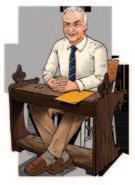

£15
plus P & P
President
IAN RIMMER
King James’s School, St Helen’s Gate, Almondbury HD4 6SG
Tel: 01484 412990
Email: Staff.IRimmer@kingjames.school
Chairman
WALTER RALEIGH
15 Thorpe Lane, Almondbury HD5 8TA Tel: 01484 308452
Email: walter.raleigh@oas.org.uk
Secretary
ANDREW HAIGH
2 Arkenley Lane, Almondbury HD4 6SQ
Tel: 01484 432105
Email: andrew.haigh@oas.org.uk
Treasurer
KEITH CRAWSHAW
5 Benomley Drive, Almondbury HD5 8LX
Tel: 01484 533658
Email: keith.crawshaw@oas.org.uk
Media Editor
ROGER DOWLING
Orchard House, Oughtrington Lane, Lymm, Cheshire WA13 0RD
Tel: 01925 756390/07815 601447
Email: almondburian@oas.org.uk
Assistant Media Editor
RICHARD TEALE
The Sycamores, 239 Huddersfield Road, Thongsbridge, Holmfirth HD9 3TT Tel: 07810 313315.
Email: richard.teale@oas.org.uk
KJS Representative
ABBIGAIL TERRY
King James’s School, St Helen’s Gate, Almondbury HD4 6SG Tel: 01484 412990
Email: Staff.ATerry@kingjames.school

Website: www.oas.org.uk
The Almondburian is distributed to OAS members free of charge. Price to non-members: £3.00